






























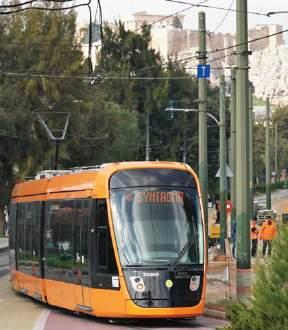
NEWS
First Flexity unveiled for Graz in Austria; Birmingham Eastside Phase 2 extension gets funding approval; Škoda wins order for new Mainz trams.
VLR UPDATE
248
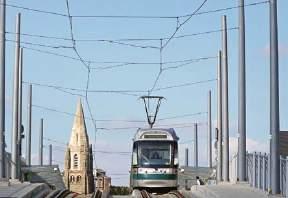

g O i N g OVER OVER h EAD
263
Richard Foster provides an update on a staple of tramways: overhead, and looks at the latest innovations in this field.
SYSTEMS fACT fi LE : AT h ENS
253
TAUT joined light rail enthusiasts in Coventry, UK, to witness the public launch of the city’s VLR system – could this be the start of an even lighter rail revolution?
T h E f UTURE i S A i
268
Neil Pulling visits the classical home of democracy. Hosting the Olympic Games prompted a review of public transport, leaving a new LRT system for the city.
WORLDW i DE REV i EW
255
TAUT looks at all the ways in which Artificial Intelligence is tranforming how we run our tramways.
RENEWAL i N WROC Ł AW
Network enlargement and fleet renewal continue at pace in this Polish city; Andrew Thompson uncovers the latest developments.
259
275
Besançon receives first new Alstom Citadis; Helsinki secures funding for new line.
UPDATES AND i NNOVAT i ON 279
UKTram reflects on the progress it has made so far in 2025.
CLASS i C TRAMS: h ANNOVER
280
TAUT visits one of Germany’s largest classic tram collections in Hannover.

It is almost 20 years since Alistair Darling, the UK Labour Government’s Transport Secretary, pulled the plug on four advanced light rail schemes because he was not convinced that they represented value for money or were even necessary. The cities themselves, manufacturers and suppliers, were livid, but powerless to react.
Governments and parties are famous for policy U-turns, and Darling’s successors in the new – Labour – government have a completely different view and put railborne urban transit at the very heart of their GBP15.6 billion (EUR18.5 billion) announcement on 4 June to appease elected mayors.
This means firm approval for the West Yorkshire Tram for Leeds and Bradford, and extensions for the West Midlands, Manchester, and Tyne and Wear systems. None of these ideas are new, but the additional prospect of taking Nottingham Express Transit to Derby is. Bristol, axed by Darling in 2005, could happen, but there is no revival planned yet for the lapsed schemes for Liverpool and South Hampshire.
Is it better late than never? Yes. All this indecision has cost our economy multiples of billions in lost opportunities – industrial growth, regeneration, enterprise and job creation. World countries offering good public transport have leapt ahead.
The other fly in the ointment is that Labour, only one year into its five-year term, has fared badly in recent opinion polls, so is not guaranteed to be in power at the end of the decade. Do the other political parties battling for election have the same enthusiasm?
We will all hear a lot more from Light Rail Minister Simon Lightwood, who will be attending the 2025 UK Light Rail Conference in Leeds on 22-23 July. Book your place now.
Matt Johnston, Editor
COVER: Alstom Citadis X05 20056 near Piraeus Municipal Theatre. Dimarcheio stop opened with the Piraeus
line 3

JULY 2025 Vol. 88 No. 1051 www.tautonline.com
EDITORIAL
Editor – Matt Johnston matt@mainspring.co.uk
Associ At E Editor – Tony Streeter tony.streeter@mainspring.co.uk
WorldW id E Editor – Michael Taplin miketap@mainspring.co.uk
sEN ior c o N tributor s –howard Johnston , Neil Pulling
WO rldW id E C ONT ri BUTO r S r ichard Foster, Andrew Grahl, Andrew Moglestue, Herbert Pence, Mike russell, Nikolai s emyonov, Alain s enut, Andrew t hompson, Witold urbanowicz, bill Vigrass, t homas Wagner, Philip Webb.
Productio N – Lanna Blyth tel: +44 (0)1733 367604 production@mainspring.co.uk d E si GN – Debbie Nolan A Dv ERTI s I ng
co MME rci A l M ANAGE r – g eoff Butler tel: +44 (0)1733 367610 geoff@mainspring.co.uk
Tramways & Urban Transit 13 o rton Enterprise centre, b akewell road, Peterborough PE2 6X u u K
Tramways & Urban Transit is published by Mainspring on behalf of the lrtA on the third Friday of each month preceding the cover date.
LRTA MEMBERS hi P (with TAUT subscription) Tramways & Urban Transit is sent free to all paid-up members of the l ight r ail t ransit Association.
lrtA WE bsit E AN d di A rY Tim Kendell webmaster@lrta.org meetings@lrta.org
sU bsc RI p TIO ns, MEM b ER s HI p A n D b Ack I ss UE s lrtA Membership s ecretary ( d ept t06), 38 Wolseley road, s ale M33 7Au, u K. tel: +44 (0)117 951 7785 membership@lrta.org Website: www.lrta.org f OR c OR p ORATE sU bsc RI p TIO ns v I s IT www.mainspring.co.uk
LRTA RE gi STERED OffiCE 13 o rton Enterprise centre, b akewell road, Peterborough PE2 6X u, u K Private company limited by guarantee, No. 5072319 in England and Wales.
lrtA cHA ir MAN – Paul Rowen chair@lrta.org
© lrtA 2025
Articles are submitted on the understanding they may also be used on our websites or in other media. A contribution is accepted on the basis that its author is responsible for the opinions expressed in it, and such opinions are not those of the LRTA or Mainspring. All rights reserved. No part of this magazine may be reproduced or transmitted in any form by any means, electronic or mechanical, including photocopying, recording or by any information storage and retrieval system, without prior permission in writing from the copyright owner. Multiple copying of the contents of the magazine without prior written approval is not permitted.
PR i NT
t he Manson Group l
Alstom unveiled the first Flexity tram for the Austrian city of Graz at a ceremony at its Wien (Vienna) factory on 5 May. The vehicle has now been shipped to its new home.
Graz ordered 15 Flexity vehicles in 2023 at a cost of EUR62m. It has since taken up an option for a further 16, worth EUR69m.
The three-section 33.8m trams can carry 200 passengers (60 seated). Due to enter service between 2026-28, they are expected to increase passenger capacity by 30%. They are 100%
low-floor, and the step height is just 215mm.
Deputy Mayor Judith Schwenter said: The new Graz trams are outstanding – modern, comfortable and simply beautiful. But what is particularly important is that they bring real progress for the people in our city.”
Lilian Meyer, Managing Director of Alstom Austria, added: “We are proud to be able to hand over this innovative vehicle to Holding Graz. The Flexity will significantly support Graz on its way to sustainable and barrier-free mobility.”


Strathclyde Partnership for Transport (UK) has appointed Mott McDonald to develop the Scottish Transport Appraisal Guidance for the GBP15bn (EUR17.9bn) Clyde Metro. The consultancy firm will also undertake the preliminary engineering statement that will “determine a scope and timetable for the delivery…”.
SPT CEO Valerie Davidson told Glasgow Times that the Clyde Metro is likely to feature a mix of heavy rail routes and railway lines converted to metro. Some of the latter could be extended, while new light rail lines would be created.
Should maps of proposed
routes come to fruition, the system could be larger than the current 103km (64 miles) of Manchester’s Metrolink and reach as far afield as West Dunbartonshire, North Lanarkshire and East Kilbride. Mott McDonald is working with Stantec to develop both packages for SPT. The work could be completed in 2026-27. It is likely that it could take 30 years to build the full metro system.
Graeme Smith from Mott McDonald said: “Having worked on Clyde Metro from its early stages, it’s clear that it has the potential to provide tremendous benefits, not only for Glasgow, but for Scotland as a whole.”
Metro de la 80 is being financed by the national government and the city council. It is due to open in 2028.
The Colombian city of Medellin is to build a COP3.5bn (EUR743m) 13.3km (8.3-mile) light rail line. Called ‘Metro de la 80’, its name comes from its proposed alignment along Avenida 80; it is to link Caribe and Aguacatala metro stations. The line is being built by a consortium: CRRC (rolling stock), Mota-Engil (civil construction), Ineo Urban Transportation Solutions (telematics) and Siemens Mobility (power engineering and signalling). Spanish company GMV is to install its SAE-R system on the 20 CRRC doubleended LRVs; on-board computers work with trackside beacons to provide real-time information.
The city also has a two-line heavy metro, which opened in 1995. It has five cable car lines and a 4km (2.5-mile) Translohr rubber-tyred guided bus.
Light rail is one of the major winners in a planned GBP15bn (EUR17.8bn) investment in UK transport projects. This was announced by Chancellor Rachel Reeves on 4 June, a week in advance of 11 June’s Spending Review.
Highlights include GBP2.5bn (EUR3bn) to extend Manchester Metrolink to Stockport and GBP2.1bn (EUR2.5bn) to West
Yorkshire Mass Transit to start construction in 2028. There’s also good news for Tyne and Wear Metro and Sheffield Supertram. The announcement also confirms funding for Birmingham’s East Side Extension (see separate story). A detailed look at this announcement will appear in the next issue.
West Midlands line is ‘very high value’
West Midlands Combined Authority has approved Phase 2 of the UK’s Birmingham Eastside Extension. The GBP107m (EUR127m) project was accepted on 9 May because, according to a WMCA board report, it has a “very high value for money outcome assessment”.
The GBP227.2m (EUR271m) 1.7km (one-mile) Eastside Extension was approved in February 2020 and construction started in 2021. Phase 1 – from Lower Bull Street to a temporary terminus outside the Clayton Hotel close to the site of the future HS2 Curzon Street station
– should open later this year.
WMCA mayor Richard Parker told Express & Star that GBP62m (ERU74m) towards Phase 2 had been “fast-tracked” in order to accelerate the construction process.
“The sooner we deliver it, the sooner we bring in the jobs, homes and regeneration promised by the Sports Quarter”, he said.
The latter is a GBP100m (EUR119m) redevelopment plan to the east of Digbeth. It is led by US firm Knighthead, which owns Birmingham City football club and centres around the construction of a new 62 000seat stadium.
The Eastside Extension has been divided into sections. Phase 2 comprises three sections. Section 5, from Digbeth to the southern end of Meriden Street is largely complete. Sections 3 and 4 will connect this with the Clayton Hotel terminus.
The WMCA report said that: “Advanced utility diversions have commenced to support the efficient delivery of Sections 3… and 4 [New Canal Street –Meriden Street].”
Section 3 (Park Street – New Canal Street) cannot start until 2026, when HS2 hands this land over to Midlands Metro Alliance, which is undertaking construction.
Russia’s capital Moskva (Moscow) has ordered 100 bogie trams from PKTS of Sankt Petersburg (Saint Petersburg). They are
reportedly based on the PKTS 71911EM design. The order is worth RUR39.9bn (EUR437m) and includes 30 years’ maintenance.
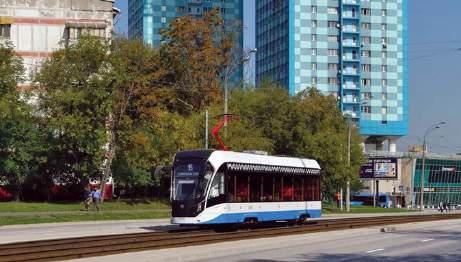
The trams will be based at the recently-rebuilt Apakov depot and are to replace 40 71-623 trams that date from 2012/13. They will provide for expansion of the city’s network. Delivery is due to start before the end of 2025, with most arriving by September 2026.
The trams will have traction batteries capable of providing operation for up to 4km (2.5 miles) at 20km/h (12mph) without overhead, though this capability is not expected to be used in normal traffic. They must also be capable of towing another tram for up to 3km (1.9 miles) anywhere on Moskva’s 181km (112-mile) 1524mm-gauge network.
Transport for Greater Manchester (UK) is to start the tendering process to find a new operator for Metrolink. The winner of the contract is to be announced in January 2027.
The deal is worth GBP1.6bn (EUR1.9bn). It covers the period July 2027-July 2034, with potential extension until 2038. Whichever operator takes over from Keolis/Amey would be responsible for supporting “TfGM in their procurement and delivery of Expansion Projects,
including new stops and new trams, new control systems and the development of future extensions”.
Meanwhile, Alstom and Italy’s ATM Group have put together a bid to operate and maintain Dublin’s Luas. Ireland’s National Transport Authority and Transport Infrastructure Ireland renewed the contract with Transdev to operate the 42.1km (26.2-mile) system in 2014. However, both organisations announced in 2023 that they
Portland’s LRV option
The Portland TriMet (US) budget for the fiscal year beginning 1 July includes USD66.1m (EUR58.5m) for the purchase of additional Type 6 LRVs, utilising soon-toexpire options under the existing contract with Siemens. Pending the approval of supplementary federal funds, the amount will allow the Portland transit agency to replace 26 of its 52 Type 2 LRVs.
Meanwhile, TriMet and Siemens have been negotiating since 2023 to curtail or terminate the 2019 contract for a ‘Mid-Life Overhaul’ of all 79 SD660 LRVs. Only four cars have received the overhaul, with the last – 241 – still at Siemens’ Sacramento factory.
Serbian contract confusion
An order by Beograd (Belgrade) for 100 new trams with Astra Vagoane (TAUT 1050) has been suspended. It is understood that the decision to re-tender was due to an intervention by the trade union Centar-GSP Beograd as it wants the trams to be built in Serbia. The country’s only tram factory is owned by Siemens.

Nantes celebrated the opening of its 1.4km (0.9-mile) line 1 extension from Rue du Ranzay to Babinière on 23 May. Babinière’s new EUR93m depot and parkand-ride/bicycle park (France’s largest bike park) opened the same day. The tram now crosses the city boundary for the first time, into the municipality of La Chapelle-sur-Erdre.
would not renew the contract when it expires in 2026.
Alstom provided the Luas’ fleet of 81 trams and is currently building battery EMUs for Dublin’s DART+ heavy rail system. Its Managing Director Ireland, Piers Wood, said: “We are proud to partner with ATM to offer a compelling proposition for the Luas O&M contract.
Our shared commitment to reliability, sustainability and innovation is at the core of this venture.”
The EUR50m project includes a crossing of the river Erdre and a new 87m bridge over the Ring Road that also accommodates pedestrians and cyclists. There is now an interchange with tram-trains on the Nantes –Châteaubriant line. Journey time to the city centre is 30 minutes. Trams operate every 15 minutes (nine minutes at peaks).
Meanwhile, tram development continues at Babinière, where line 6 is under construction that will provide a link to line 2.
Škoda Group has won a contract for 22 new 100% low-floor trams from the Supervisory Board of Mainzer Stadtwerke AG, the tram operator in the German city of Mainz. The 43.5m ForCity Smart cars are due to be delivered in 2028-2030.
Costing EUR4.6m per tram, the new five-section doubleended vehicles will replace the city’s last Stadtbahn-M cars and its 16 ADtranz GT6Ms, which date from 1996. Air-conditioned, the vehicles can carry up to 258 passengers (96 seated).

Škoda Group’s President of the North Region, Jan Christophe Harder, said: “Mainz is a city with a long tram tradition, and it is fantastic that this history is now being continued with modern and sustainable vehicles. We will deliver reliable vehicles to Mainz that will shape people’s mobility for years to come’.
Tramwaje Ślą skie through services in Poland were restored between B ę dzin and Sosnowiec on 17 April. Line 21 (Milowice – Tworze ń – Huta Katowice) resumed its normal route, having been affected by closure of the track on Stefana Ż eromskiego, while temporary route 47 was withdrawn. Line 22 to Czelad ź has been replaced by buses due to work taking place on the section west of B ę dzin Rondo.
Our report about the discontinuation of tram service Szopienice Dwór – Szopienice Pętla through the tunnel under the railway (TAUT 1050) was superseded by events. Lines 14 and 25, the only two to use this section, were withdrawn from 28 April. Line 14 has been replaced by line 36 (Brynów – Katowice – Zawodzie), where transfer can be made to new shuttle line 44 to Szopienice Dwór.
This replaces lines 14 and 25 over this section and doubleended Moderus Alfa cars are used; also replaced is the 111N set on line 34 within Mysłowice. Line 15 through Szopienice Dwór to Sosnowiec appears unaffected. Line 41 replaces part of line 11 within Katowice (Słoneczna – plac Miarki) as it is rerouted via the new track in Grundmanna. This now operates through to Zawodzie interchange in place of plac Miarki.
Joint Managing Directors of Mainzer Stadtwerke AG, Jochen Erlhof and Florian Wiesemann, added: “New vehicles are absolutely necessary to ensure… long-term reliable operation of the trams in Mainz. At the same
time, [they] will help cope with growing passenger numbers… last year our passenger numbers reached the record level of around 56.9m, exceeding [the] pre-COVID total for the first time.”
Wiener Linien, the transport operator in the Austrian capital, has joined forces with the city council to persuade tram passengers to carry parcels. The eight-week trial was due to start at the end of May, using 150 volunteers.
The three solar-powered parcel boxes have been placed at Kagran on lines 25/26, at Konstanziagasse on line 25 and at Hausfeldstrasse on line 26. These locations were based on analysis of passenger flows. Volunteers receive a QR code to open a parcels box when they use the Öffi-Packerl app to register their journey. They then carry the parcels, leaving them at another box for recipients to collect. There are restrictions on the size of the packages that can be carried.
The trial is based on a 2021 feasibility study that identified 90% of residents were willing to collect parcels from their nearest

tram stop, and 65% of residents would be willing to deliver parcels as part of their journey.
The aim of the trial is to offer an environmentally-friendly
Amsterdam’s public transport operator GVB has published its 2026 planning document, which includes changes to the Dutch tramway network:
• Line 25 is to be extended over existing tracks from Station Zuid to Station Muiderpoort.
• Line 12 is to terminate at Zoutkeetsgracht rather than Centraal Station.
• Line 7 is to run to Flevopark instead of Azartplein.
• Line 1 is to run to Azartplein instead of Station Muiderpoort.
• Line 3 is to be withdrawn
alternative to delivery vans.
The project is funded by the Federal Ministry for Climate Action through the Austrian Research Promotion Agency.
• Line 26 is to receive a new extension to Strandeiland. Although the city is to celebrate 150 years of its tramways (and 125 years of electric tramways) on 27-28 September, Vijzelstraat will lose its tramway.
Transport for London is set to issue tenders for contracts to either replace life-expired systems or to keep them operational. The UK system opened in May 2000 and still has 23 Bombardier CR4000 trams from its first days in service. A contract is being offered to fix issues with the fleet such as leaking roof seals, worn pantographs and cracked underframes.
The three-year project is due to start on 1 April 2026. While a tender has separately been issued for new trams (TAUT 1035), Transport for London says that this new
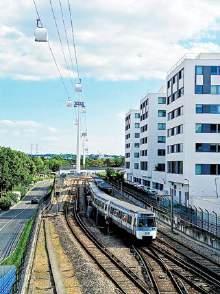
Line C1 in the French capital Paris is expected to carry passengers before the end of the year. Trials have started on this Transdev-operated cable car that links the metro line 8 station at Creteil-Pointe du Lac with Valenton, LimeilBrévannes and VilleneuveSaint-Georges (Villa Nova). The 4.5km (2.8-mile) system has five stations. It is supported on 30 pylons, ranging in height from 43m to 55m. Served by ten passenger cabins on a 30-second frequency, the journey time will be 18 minutes and 11 000 passengers/day are expected.
contract will “resolve these issues without having to implement timetable reductions”. Bids are due to be received from 30 June.
Meanwhile, a tender is to be offered over the summer to replace control equipment on the London Trams network, worth an estimated GBP42m (EUR50m). This covers two key areas. The first is the replacement of the Tram Management System, which feeds data from across the network back to the control room.
The second area is the replacement of Programmable Logic Controllers that are installed around the network which, TfL says, “provide
autonomous local decision making and control of aspects of the signalling and control system”.
The contract comprises a two-year delivery period and five years of maintenance. There is an option to extend the latter for up to a further 15 years.
Also on offer is a contract to build an additional stabling siding capable of holding three trams as well as constructing a new store building. The location of the GBP8.4m (EUR10m) contract has not been disclosed but is assumed to be at the Therapia Lane depot. Work on the year-long project could start on 28 November.
Tenders have been invited for a two-line tram network in the South Korean city of Hwaseong.
Dubbed the Dongtan Tram, the network is to comprise a 13.8km (8.6-mile) line from Mangpo metro station to Banggyo-dong and a 17.8km (11-mile) line from Byeongjeom metro station to the Great Train Express Line A’s Dongtan terminus.
Construction could start this year. Both lines are to be catenary-free with either batteryor hydrogen-powered cars.
Passenger services could start in 2028.
Hwaseong is served by one station (Byeongjeom) of Seoul metro line 1. It has been designated a Special City, with the emphasis on sustainability. Its population has grown from 210 000 in 2001 to one million and it is now home to the largest number of companies of any city in South Korea. It plans to attract KRW20tr (EUR12.8bn) in corporate investment by 2026.

Changes to the road layout at key junctions could, councillors believe, become the foundation for a tram route across Bristol (UK). The changes will initially create a dedicated route for buses, but this is being eyed as a future segregated route for a tramway. It would link Long Ashton in the southwest of the city to the M32 motorway to the northeast, a distance of approximately 8km (five miles).
Green Councillor Emma Edwards said: “This in future could potentially turn into a mass rapid transit route, whatever that might mean –more buses or maybe other modes as well.”
West of England Mayoral Combined Authority published a Strategic Outline Case for mass transit in 2023, Bristol Live reporting that a GBP7.8m (EUR9.2m) full business case could be published in 2029-2030.
LAX Transit Center opens
The LAX/Metro Transit Center station on Los Angeles’ light rail Line K was to open on 6 June with a through service operating from Expo/Crenshaw to Redondo Beach. The new US station has a free shuttle link to LAX airport terminals, which is to be replaced by an automated people-mover in 2026. The station is also the new terminus of Line C to Norwalk, with the Aviation/ LAX station renamed Aviation/ Imperial.
However, construction of the 2.6km (1.6-mile) Inglewood Transit Connector has been paused after it became apparent that it could not be completed in time for the 2028 Olympic Games. The USD2.4bn (EUR2.1bn) light rail line would have linked Line K with event and entertainment facilities. Shuttle buses will run instead.
Spanish power cuts
Transport across Spain and Portugal was left in chaos after mass blackouts on 28 April. The electricity supply across the Iberian peninsula fell from 26 695 to 15 970 megawatts at approximately 12.30. It affected cities from Lisbon to Madrid, and Barcelona to Perpignan, just across the border into France. More than 50 Madrid metro trains were left stranded in tunnels, with passengers evacuated on foot. Many metro operators resumed full services the following day. An investigation into the cause of the power failure has been launched.
Budapest funding difficulties
CAF has delivered the eighth tram out of a total order of 51 to the Hungarian capital, Budapest. However, news outlet Népszava reports that transport operator BKK only budgeted to pay for 0.56% of the order, with the remaining funds coming from the Hungarian government. Much of that money was intended to come from European Union funds but the EU has withheld billions of euros due to a dispute over alleged rule of law violations. It is not yet clear whether CAF will supply all 51 new trams. Meanwhile, tenders have been invited for the construction of a new 2.8km (1.7-mile) tramline on the west bank of the Düna (Danube) river, which would run from Szent Gellért tér to the future Nádorkert commuter rail station.
The USD1.2bn (EUR1bn)
Bellevue light rail line opened in Seattle (US) on 10 May. This adds 5.4km (3.4 miles) to the 10.6km (6.6-mile) Redmond Technology – Downtown Redmond light rail line that opened in April 2024.
Transit provider Sound Transit has been disappointed by the average 4000 daily ridership on the Redmond light rail line, despite a ten-minute headway. However, the route is unlikely to reach its full potential until the 6.4km (four-mile) link to downtown Seattle (International District/Chinatown) is completed in early 2026. This is part of Seattle’s plans to host FIFA World Cup football

matches, alongside other cities in Canada, Mexico and the US. Redmond mayor and Sound Transit board member Angela Birney said: “Today is an historic milestone for Redmond and our region… an achievement made
The death occurred on 6 April 2025 of David Russell, a long-serving member of the Light Rail Transit Association, who became Secretary and Chairman of that body. He passed away in a Derby hospital at the age of 87, with his son Huw by his side.
David Francis Russell was born on 4 October 1937. His family was from Wales. His father Cyril worked for the Taff Vale Railway and then (after the 1923 groupings) the Great Western Railway. In 1934 the family moved to Birmingham, where David was born. He went to St Phillip’s Grammar School there, and later secured a BSc (Eng) from London University in 1961. From an early age he loved transport, standing tall at the front of his pram while his mother Blodwyn pushed him.
David followed his father into the railway industry, beginning with an engineering
apprenticeship at Derby Locomotive Works. He held successive appointments in the industry at Crewe, Paddington, Old Oak Common and King’s Cross.
David married Julie Parker in Cardiff in 1972. They moved to York in 1976, David having been appointed Eastern Region Traction Engineer. Huw was born in 1980.
David secured a promotion as BRB Freight Engineer in 1982, so the family moved to Derby. Ten years later, he became Director, Traction and Rolling Stock for Railfreight Distribution. He retired in 1993, but continued working as a rail consultant, duties for which took him to Hong Kong, Kuala Lumpur and the United States.
David’s interest in tramways arose from his association with Arthur Camwell, who he came to know as a result of participation in the latter’s rail tours. ‘Cam’ was a hero to

possible by decades of vision, planning and leadership. With the opening of the Downtown Redmond Link, Sound Transit now operates 46 miles [73.6km] of light rail across all three counties we serve.”
David, who became a member of the Association (then the Light Railway Transport League) and joined many of its overseas tours (on one occasion the Soviet authorities fogged his films and the military marched him to his UK-bound aircraft!). More happily, he was a participant in a notable tour to the works of CKD, the Tatra tramcar manufacturers in Praha – then still behind the Iron Curtain.
After election to Council, he served as Secretary from 1966-76, Deputy Chairman between 1988-2002 and Chairman of the Association from 2002-08. On relinquishing the last office, he was appointed a VicePresident. A highlight during his term of office was the hosting of the Czech engineers who had received the Association party on their visit to CKD Tatra.
David was a fellow of the Institution of Mechanical Engineers and a Member of the Chartered Institute of Logistics and Transport, as well as a member of several other transport societies, including the Tramway Museum Society of which he was Chairman for a time. He maintained a close relationship with many railway organisations.
In 2021 his beloved wife Julie passed away following a stroke. David had cared for her for the previous five years.
Huw survives David, and is a solicitor and director in the climate team of the public sector consultancy Local Partnerships. While he doesn’t share quite the same passion as David for railways and tramways, he is a big fan of public transport and supporting public sector services.
David suffered a heart attack in 2004 and more recently a general decline in health, passing away from heart failure.
He will be remembered fondly by all who knew him.
HR, MW & GBC

it’s cheap to build and environmentally sound... could this be the beginning of a true light rail revolution? TAUT has been to visit the trial of vLr in the Uk's West Midlands.
After a decade of planning and development, the Very Light Rail (VLR) concept has now been unveiled to the public in the UK city of Coventry. Everyone now waits to see whether it really is the way forward for low-cost urban transit for other cost-conscious cities to follow the initiative.
With a population of less than half a million, Coventry in the West Midlands has never stood a chance of getting a full-blown light tramway system, and this is also the case for medium-sized population centres across the rest of the country.
The UK government has given its blessing by awarding substantial cash grants for the first phase. It is hoped that up to six routes around Coventry can be quickly developed, and orders placed for a fleet of vehicles more advanced than the prototype, which is now two years old.
Two days later than planned, the prototype VLR tram carried its first passengers on demonstration runs on 30 May, using 220m of newly-laid modular slab track in Greyfriars Road and Queen Victoria Road in the city centre, a five-minute walk from the main railway station. A key selling point is that there has not been any need to dig up clean
and foul water and gas pipes, and electricity and telecoms cables.
Construction was undertaken within a strictly constrained corridor, with no full road closures or traffic diversions required. Installation required a 14-tonne wheeled excavator, a small breaker and a dumper, and the relatively low weight slabs could be handled by a small crew. There is no permanent boarding platform, and track will be left in place to test its reliance under continuous normal road traffic.
The formation includes a 3.5% gradient and a 30m radius curve, which was laid in a 30cm excavation by Colas Rail UK.
The two-axle, 11-tonne vehicle that can accommodate 56 passengers (20 seated) was manufactured in Coventry by NP Aerospace and tested on a 2.2km (1.4-mile) track at the Very Light Rail Innovation Centre in Dudley. It is battery powered with a theoretical range of 50-70km (30-45 miles), but this varies with temperature and vehicle load. It can be charged from 10% to 90% in 12 minutes using a 450 kW Furrer+Frey opportunity charger. This was originally designed for use with buses, and has a pantograph that lowers from above, rather than one fitted on the roof of the vehicle. It is not charged to 100%, to leave capacity for regenerative braking.
Rail Adventure UK has provided operations during the May/June demonstration period (for which all passenger trips were sold
It has been announced that there are serious plans to install the first revenue-generating VLR line in Coventry, which couldrun from the station to the University Hospital, and has the support of the city council. Other routes are to the University Technology Park on Puma Way, the airport and Gigafactory, Ansty Technology Park, and the University of Warwick.
VLR has the potential for autonomous operation similar to the London Underground once the technology matures. Its construction cost is put at GBP7m (EUR8.4m) per km. The costs of development and trials in Coventry are around GBP14.6m (EUR16.6m) , with GBP2.4m (EUR2.9m) coming from the Coventry and Warwickshire Local Enterprise Partnership and the remainder from the West Midlands Combined Authority.
Mayor of the West Midlands, Richard Parker, said: ‘This revolutionary VLR technology, in which the West Midlands is leading the way, will slash costs and accelerate construction time for tram networks, allowing us to better deliver on my vision to connect communities with more affordable and accessible public transport’.
The ambitious VLR venture began as a collaborative effort between Coventry City Council, WMG University of Warwick, and
Transport Design International (TDI). Mayor of the West Midlands Richard Parker has said: “This revolutionary VLR technology, in which the West Midlands is leading the way, will slash costs and accelerate construction time for tram networks, allowing us to better deliver on my vision to connect communities with more affordable and accessible public transport.”
Real-world testing is crucial. Construction of the test track in the city centre only began in March, and the protocol is to put safety and public engagement first. Initially, the VLR vehicle is carrying invited guests rather than fare-paying passengers, allowing for controlled evaluation of the system’s performance under real operating conditions. This approach enables the project team to gather valuable feedback on both the vehicle’s operation and the innovative track design before progressing to a full roll-out.
The planned next stage of testing involves an 800-metre stretch of mainly doubletrack running from Warwick Road, close to Coventry station, to Corporation Street, north of the city centre. This extended demonstration track provides additional opportunities for public engagement and system evaluation. The council has specifically designed this phase to gain feedback on both the vehicles and the overall VLR system operation, creating a foundation for informed decision-making about future expansion.
The VLR vehicle’s low emissions at the point of use align with contemporary environmental goals. Its lightweight design requires less infrastructure compared with conventional trams, potentially lowering installation and maintenance costs by a substantial margin. The innovative track, developed in partnership with engineering specialists, aims to minimise the disruption typically associated with light rail installation by using existing roadways where possible.
Testing at the controlled environment of the VLR national testing facility in Dudley has allowed engineers to evaluate the vehicle’s performance characteristics before moving to the on-road trials, ensuring safety standards are met and operational parameters are optimised.
The successful completion of the current tests will trigger the next stage of the Coventry VLR project’s development, and it is hoped that construction of the first full commercial line could begin later this year, with opening before the end of 2026.
Route planning remains under active development, with engineers and urban planners working to identify the best corridors to maximise the system’s benefits while minimising disruption to existing infrastructure. The selection process will consider passenger demand, connectivity to existing transport networks, and technical feasibility given VLR’s unique characteristics.
The concept was designed with scalability in mind, offering the potential for expansion across Coventry and potentially to other UK cities facing similar urban mobility challenges. Lower infrastructure costs compared with conventional light rail will certainly be attractive to municipalities

above: both the vLr tram and the track offer innovative alternatives to traditional tram and tramway construction, and align with contemporary ecological goals. Andrew Moore
right: building the track required no road closures or traffic diversions, with installation requiring only a shallow 30cm excavation along the route.
Tim Kendell
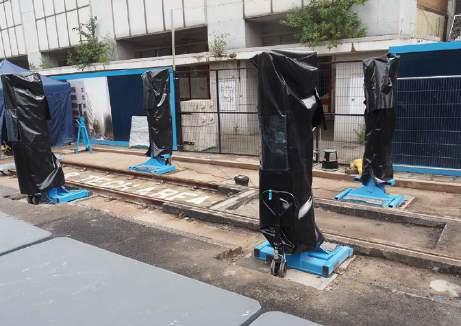
right: the vLr tram makes its way along the test track at the end of May. battery-powered and weighing 11 tonnes, it can carry up to 56 passengers.
Andrew Moore
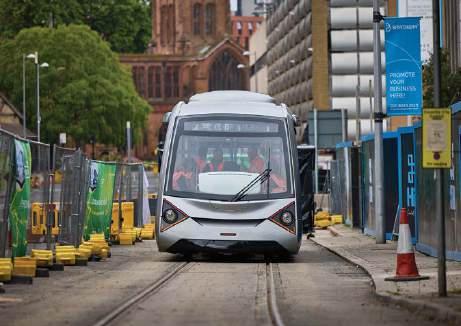
with growing transport needs but tight budgets. West Yorkshire and Stoke-on-Trent have already expressed interest.
Technological advancement remains central. The development team continues to explore autonomous operation capabilities, which could transform the VLR from a traditional guided transit system into something approaching the automated
efficiency of modern metros. This will keep operational costs in check, and also enable more flexible and responsive service patterns.
As climate change concerns drive demand for sustainable transport, the zero-emission VLR system positions itself as a serious and viable alternative to both diesel buses and more expensive heavy rail solutions.

how can Artificial Intelligence transform light rail? TAUT gives an overview.
Artificial Intelligence. AI. Concepts that are ever more part of everyday life. From chatbots when you contact a utilities company, to the AIgenerated answer that automatically appears when you tap a subject into Google – not to mention ChatGPT that will generate articles on topics of your choice, or the programmes that create realistic-looking ‘photographs’ of fake scenes or people.
Recent advances in AI have been remarkable.
What does this have to do with light rail? The answer is… everything.
Imagine a world where anyone falling onto the track is automatically detected, where vehicles are repaired before rather than after they fail, where trams put themselves away at night, or where delays are cut because problems can be predicted before they happen.
All this is possible, now.
Let’s start with an explanation, because AI is a pretty all-encompassing term. According to America’s National Aeronautics & Space Administration (NASA) there “is no single, simple definition of Artificial Intelligence because AI tools are capable of a wide range of tasks and outputs”.
NASA though, follows a definition that has been used in a US Executive Order,
which itself references the country’s National Defense Authorisation Act. That defines AI as:
• Any artificial system that performs tasks under varying and unpredictable circumstances without significant human oversight, or that can learn from experience and improve performance when exposed to data sets.
• An artificial system developed in computer software, physical hardware, or other context that solves tasks requiring human-like perception, cognition, planning, learning, communication, or physical action.
• An artificial system designed to think or act like a human, including cognitive architectures and neural networks.
• A set of techniques, including machine learning that is designed to approximate a cognitive task.
• An artificial system designed to act rationally, including an intelligent software agent or embodied robot that achieves goals using perception, planning, reasoning, learning, communicating, decision-making, and acting.
It is therefore pretty wide-ranging. Yet if, in the past, automation has largely involved replacing human activity for mechanical tasks, you can broadly say that AI can take over activities requiring people to think and
make decisions. Hence why its applications –including in light rail – can be so broad.
When we talk about AI, we often more specifically mean Machine Learning, the training of computers using data and algorithms. Doing that needs lots of data on whatever it is we want the system to learn and do.
AI’s rapid development is coming about now not only because of the sheer amount of computing power available, but also because the available data is increasing all the time.
What, then, are some of the ways AI is either already employed in light rail, or can be?
Some applications are those that can be used in any field. For example, the UK Government has announced plans to use AI for administration tasks. In April it described a trial within the National Health Service as a “gamechanger” – with more patients seen, clinicians spending more time focusing on the patient, and shorter appointments.
At a UK Railway Industry Association event, computer company IBM reported that more than 300 000 users now experience HR processes through an AI assistant – resulting in a 40% saving.
Overall, the financial benefits of AI could be huge. A UIC (international union of railways) report produced in partnership with consultancy McKinsey suggests that greater adoption could be worth up to USD22bn (EUR19.8bn) per year.
For a USD5bn (EUR4.5bn) railway company, McKinsey estimates that AI could deliver USD700m (EUR630m)
of value per year through revenue management and capacity optimisation on the one hand, and reduced costs on the other through optimising crew staffing, predictive maintenance of rolling stock and infrastructure, and automation of corporate functions.
Yet what about specifically rail-based applications?
In March, the UK’s Light Rail Safety & Standards Board announced it was partnering with Starling Technologies to combine cameras with AI in a “groundbreaking project… to improve safety at tramway crossings”.
The cameras are being installed at NonMotorised User (NMU) crossings “to observe and analyse the behaviour of pedestrians… identifying potential risks and opportunities for safety improvements.”
Not only will crossings be monitored (as
happens already), but data gathered will be analysed by AI to seek improvements.
“Understanding user behaviour at NMU crossings will help us develop data-driven strategies to reduce risks and ensure safe interactions between light rail vehicles and pedestrians,” said Craig O’Brien, Head of Engineering Safety and Innovation at LRSSB.
“The findings from this project will contribute to a broader discussion on NMU safety, potentially shaping future policies and technologies to enhance light rail operations nationwide.”
Or consider London’s Docklands Light Railway. The fear of falling from a busy platform onto the track is something any passenger in a metropolis can surely identify with.
The UK’s DLR carries 380 000 passengers per day. Crowds are a fact of life.
However, for the last three years, the London system has combined CCTV with AI to create an automatic visual recognition

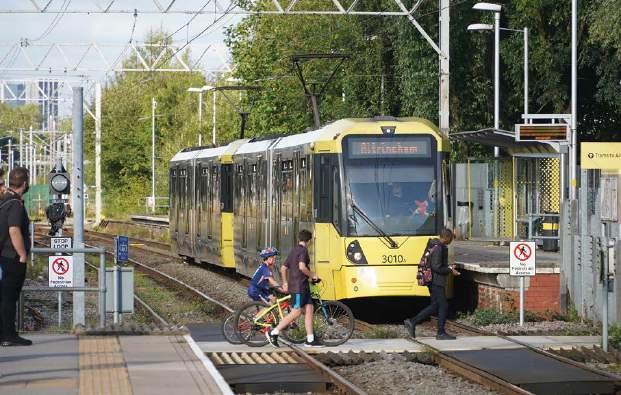
system. This can distinguish between things that should be on the track – such as trains – and things that shouldn’t. If the system detects the latter, it alerts the control centre, so that operators can take action.
This, operator Keolis Amey Docklands, said, was “an entirely new approach in the United Kingdom.”
Disruption and delays are among the things that most frustrate passengers and cause operators the biggest headaches. So, imagine a world in which these are reduced to a minimum.
In Germany, Deutsche Bahn is already using an AI system that it believes can make a big contribution towards this – saying that in Stuttgart, where it was trialled on the city’s S-Bahn network, it can “compensate for delays of up to eight minutes”.
The system has since been rolled out in other cities too.
If two trains reach a single-track section simultaneously, the system “calculates in a fraction of a second which train should pass through the section first. Dispatchers can fast-forward to a possible future scenario just as if it were a video clip, and see how recommendations will affect traffic before making a decision.”
Through live analysis, AI can also “report possible conflicts at an early stage” and “enable dispatchers to take preventive action that was not possible in the past”.
Early identification of problems also helps passengers in another way: information about probable delays can be conveyed earlier.
However, by running systems more reliably and efficiently, AI also allows the capacities of routes to be increased. Says DB: “In theory, for example, Artificial Intelligence could be used to run 17 more trains per day in each direction on Stuttgart's core route.”
Other systems also use AI for similar purposes: in Karlsruhe, the building of a new Stadtbahn tunnel (opened in 2021) led to the adoption of AI to predict problems and optimally regulate traffic.
Given that AI can help predict demand, it can also say when there is likely to be insufficient capacity, allowing controllers to respond and passengers to better understand when seats may be scarce.
An example of this is that Keolis Nederland uses AI to predict ridership levels based on weather conditions.
Such systems can also be used in timetable planning, including the planning of engineering works.
Passengers like to gain advice and reassurance – particularly when things go wrong. But does that reassurance have to come from a human?
In 2021, customers at the UK’s Newcastle Central station (where main line trains interchange with the Tyne and Wear Metro) could interact for the first time with a digital customer service avatar.
‘Ella’ was a collaboration with DB using SEMMI (Socio-Emphatic Human-Machine Interaction). Sited on Newcastle station’s concourse, it was trained to answer travellers’ queries.
AI ‘chatbots’ are also increasingly in use – such as in France's Île-de-France region where an intelligent version named Keobot is designed “to help passengers navigate the often complex fare structure of the Île-deFrance transit network.”
In the UK, Network Rail uses One Big Circle’s Automated Intelligent Vehicle Review system to gather infrastructure information. What once required visual inspection by humans walking the tracks, or complex measurement trains, can now be undertaken using what NR describes as a “phone-sized device”. This is mounted in a case on the rear of trains, or on the inside of windscreens, and captures high-definition video.
NR says the information collected “includes location data, hazards on or near the line, vegetation that may need maintaining and even the condition of the track and bridges, tunnels and viaducts.”
Cited benefits include both safety (because fewer people need to go to safety-critical areas) and efficiency.
According to One Big Circle, machine learning can be used to detect lineside assets –including things such as scrap rail. Structures can be measured, images annotated and exported, and information shared.
“Ultimately,” says NR, “it helps us look after your railway better so we can give you better journeys and a more enjoyable trip by preventing the issues that cause delays or cancellations.”
Similar systems have been developed by others, including Hitachi and Siemens. Such approaches can be used to improve vehicle maintenance and reduce the need for physical inspection time in this area too, using a combination of cameras that record vehicle condition – plus AI that analyses and sends the results to maintenance staff.
Where next?
Back in 2018, off the back of Germany’s InnoTrans trade show, Siemens and local operator ViP showed off an autonomous tram in Potsdam, near Berlin.
Fitted with multiple sensors such as radar and cameras, the tram used algorithms to interpret situations and act accordingly. On a demonstration run, that included issuing an audible warning and then braking when a pram (without baby!) was pushed onto the track in front of it.
While AI is already being used to optimise crew shifts, Siemens points out that moving to driverless vehicles will facilitate being able to offer services on demand rather than having to stick to a fixed timetable.
Siemens Mobility’s Head of R&D Department Artificial Intelligence is Dr. Claus Bahlmann. He sees key advantages in the adoption of AI: “With automation –powered by AI – we can increase flexibility to deal with varying peak travel times, reduce the downtime caused by maintenance and staffing issues, and even carry out upgrades without affecting rail operation so much. All of this benefits the passengers.”
So, while AI is already transformative, that transformation seems as if it will only
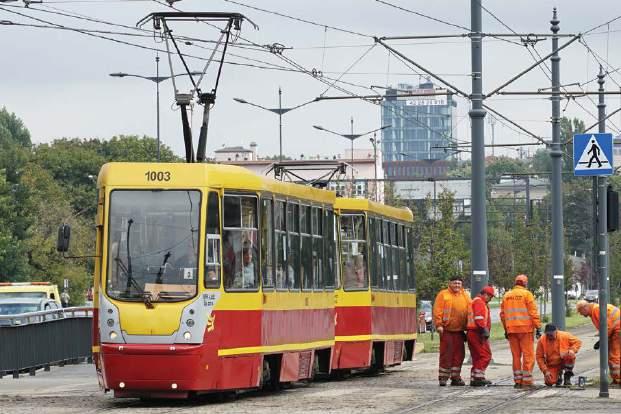
ABOVe: Images like this, where an inspection team examines the track along Piłsudskiego Avenue in Łódź (Poland), could be largely consigned to the history books as AI helps the shift towards predictive maintenance of stock and infrastructure. Neil Pulling
rIght: AI can help to predict demand, identify problems early and optimise traffic flow –Keolis nederlands uses AI to predict ridership based on weather conditions. Pictured is St Peter’s Square metrolink stop, in manchester, UK –where the weather can often be variable.
Adam Fagen, Flickr CC BY-NC-SA 2.0
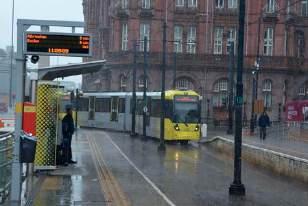
“By running systems more reliably and efficiently, AI allows the capacities of routes to be increased –in theory, to run 17 more trains per day in each direction on Stuttgart’s core route.”
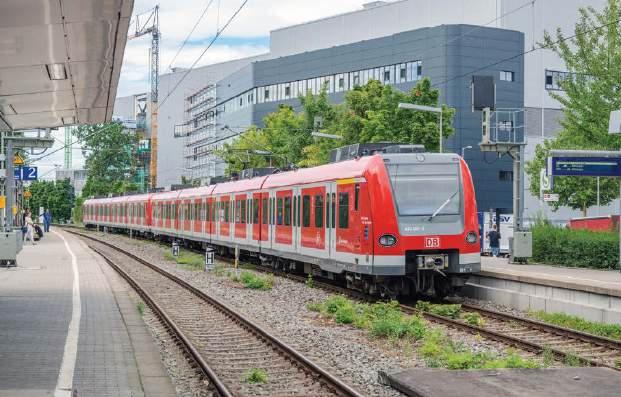
continue. Norway, for example, has partnered with Siemens to build a complete ‘digital twin’ of its railway. This can then be used to test different scenarios, as well as for machine learning. It’s part of a project to digitalise the country’s rail infrastructure by 2034. Clearly then, AI has a big part to play. McKinsey, though, does also raise a
note of caution: “While transformative, Artificial Information can bring a new set of risks that may need to be addressed from the beginning,” it says, suggesting that organisations looking to adopt it need to prioritise “strong data governance and robust cyber security”. Welcome… to the future.
Established
Comprehensive system and project factfiles
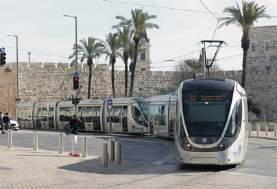


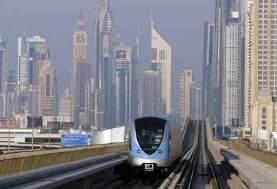






andrew thompson summarises the changes and extensions we can expect to see in this Polish city over coming years.
In the southwestern Polish city of Wrocław, both network enlargement and the renewal of the light rail fleet continue at pace. Since the last report on this city of roughly 675 000 residents (TAUT 1020, December 2022), two tramway extensions have opened in spring and autumn 2023. In mid-May of that year, the new 3.6km (2.2-mile) route from Kępa Mieszcza ń ska to Wejherowska was inaugurated in the northwest of the city, bringing light rail access to various residential districts at eight new halts, while also providing interchange to commuter trains at Wrocław Szczepin station. Later, in early September 2023, the 4.6km (three-mile) extension from Park Biznesu to Nowy Dwór P+R was launched, serving nine new stops before terminating at Nowy Dwór railway station. After these major infrastructure projects significantly enhanced public transport and rapid transit in the west of the city, officials are now looking to improve the tram system in the south and east.
One of the most important investments during the coming years will,be the longplanned tram route to the Psie Pole district

Jeleniogórska Wschowska
Leśnica
Złotnicka Kamiennogórska
Kosmonautów Grabowa Aleja Architektów
Tarczyński
Stadion Wrocław Glinianki
WR. - Nowy Dwór
Wejherowska
Niedźwiedzia
N.B. Not all stops have been named due to space constraints. Strzegomska 148
NUMBERED STOPS
1. Wrocław Nadodrze 2. Dubois
3. Kępa Mieszczańka 4 & 7. Rynek
5. Uniwersytet Wrocławski
6. Plac Orląt Lwowskich
8. Narodowe Forum Muzyki 9. Świdnicka 10. Opera 11. Renoma
12. Dworzec Główny (MDK)
13. Dworzec Autobusowy
14. Galeria Dominikańska
15. Plac Wróblewskiego
16. Urząd Wojewódzki (Muzeum Narodowe)
17. Hala Targowa
18. Katedra
19. Ogród Botaniczny 20. Kochanowskiego
Park Tysiąclecia Zemska Budziszyńska Rogowska Rogowska (P+R) Strzegomska
Babimojska Park Biznesu
Grabiszyńska (Cmentarz II) Grabiszyńska (Cmentarz)

Nowodworska Dolmed Śrubowa Smolecka Oporów
Wielka
Aleja Pracy Ojca Beyzyma Mielecka
Jastrzębia
Przyjaźni Braterska Sąsiedzka Radio i Telewizja Krzyki Park Południowy
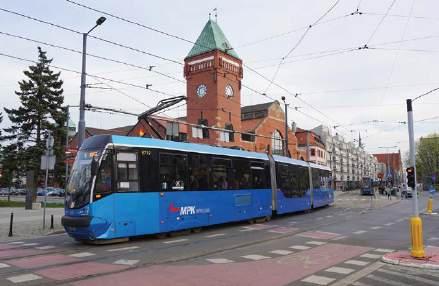
aBoVe: Showcasing its mixture of highfloor and low-floor accommodation, Protram rebuild 2712 with Modertrans type Beta body styling departs from hala targowa on 14 april 2022. to the rear is the historic market hall from 1908.
BeLoW: car 3004 is one of the single-ended Škoda 16T that have been modernised by SaatZ. these cars originally sported a grey livery that can still be seen on the double-ended 19Ts; the metallic blue makeover was introduced as part of the mid-life refit. to the rear is the main railway station Wrocław główny, which was built between 1899 and 1904, when the city was still known as Breslau and part of germany. Wrocław has been Polish since the end of World War two in 1945.

BeLoW: the Pesa Twists are currently the newest LRVs in Wrocław. these have been procured in two orders of 24+16 cars since late 2021, with the first tram arriving in February 2024. on 11 May, car 3414 passes in front of the elegant hotel Piast near the main railway station.
Right: in 2018-19, Modertrans supplied 40 Beta MF 24 AC to Wrocław. these single-ended cars have a low-floor centre module and helped make older high-floor cars redundant. they are complemented by 22 Beta MF 19 AC trams from 2015 and the 26 Beta MF 17 AC from 2020, which are rebuilds of the earlier Protram 205WrAs, originally produced in 2006-11. here 2936 from the Beta MF 24 AC series runs southbound through the city centre on line 8 towards to tarnogaj.


aBoVe: car 3207 is one of eight type 2010NW Twist supplied by Pesa in a small series in 2015. at that time, MPK introduced a dark blue livery as a modern replacement for the light blue and white colour scheme of its older high-floor cars. Since then, the corporate identity for trams has evolved to metallic blue, while buses remain yellow and red, as can be seen from the adjacent vehicle at Strzegomska interchange. this scene from 5 January 2024 is on the nowy Dwór branch in the west of the city, which opened in September 2023 and currently remains the newest network extension in Wrocław.

in the northeast of Wrocław (see ‘a’ on the map). Various route studies have already been completed and the preferred path will be selected later this year. The nearly-6km (3.7-mile) line with 12 new stops is slated for construction by 2030, and will serve neighbourhoods currently only linked by suburban rail or buses.
Psie Pole is not the only scheme on the drawing board, and the new 1.6km (one-mile) extension from S ępolno to Swojczyce in the east is presently at the most advanced stage (b). It is expected to open by 2026 and will cross the Odra Canal on a new bridge, while serving four new stops and terminating near the namesake Wrocław Swojczyce railway station. Roughly 12 000 passengers a day are expected to make use of this new connection. In a best-case scenario, 2026 should also see the launch of the 1km (0.6-mile) extension from Gaj (c), the current southern terminus of tram lines 18 and 21, to Borowska hospital with three new stops.
By 2028 the municipal public transport operator MPK hopes to be running trams on the 1.8km (1.1-mile) line to the new terminus Kupiecka in the southwest of the city (d), as a short spur from the Klecina branch off lines 7 and 17. That same year, the longer 3.2km (two-mile) extension to Ma ślice (e) should also open. This extension of the northwestern branch currently terminates at the Tarczynski Arena football stadium, will offer nine new stops and is expected to be utilised by up to 14 500 daily passengers.
Among the planned routes, a new tram line to Jagodno in the south of Wrocław is the most complex. The main challenge is that new tram tracks would be forced to cross the main line railway to Sobotka and Świdnica at grade, and national railway network manager
PKP PLK currently does not have regulations in place that permit such a scenario. As a stop-gap measure, the public transport link to Jagodno has therefore been enhanced with a new BRT system that opened in late April 2025, where buses can use reserved lanes to ease congestion and decrease journey times.
To operate the new and planned extensions, MPK is continuing on its path of fleet enlargement, while also procuring new low-floor rolling stock to gradually replace the last high-floor cars. Following on from the eight Pesa Twist type 2010NW from 2015 and the 46 Modertrans Gamma supplied 2021-24, the newest series is made up of 40 Pesa Twist of the newer type 146N. Delivery of these 29m three-section trams started in February 2024 in two sub-series and is expected to be completed by mid-2026. All of these domestically-produced LRVs from Pesa and Modertrans are single-ended, and MPK’s only doubled-ended trams remain the 31 Škoda 19T delivered in 2010-11. These are now due for a mid-life refit and in October 2024 the Warsaw-based company SAATZ won the contract for this job, after already overhauling MPK’s 17 similar Škoda 16T single-ended cars from 2021 onwards. Even with the refit of the 19T vehicles, the operational requirement for double-ended trams in Wrocław is likely to diminish, as the new route extensions are planned to feature turning loops suitable for the predominant single-ended cars.
With its continued focus on smart growth and expanded rapid transit to more corners of the conurbation, Wrocław is very much in line with developments in other Polish cities, where tramways continue to extend thanks to generous funding from a variety of different public funding mechanisms.




Deutzer’s measurement surveys are performed using regular passenger service vehicles, ensuring data collection under real operational loads.
Our flagship system, the DTK FDS4, is a state-of-the-art optical measurement system designed to assess the condition of catenary systems across railways, metros, light rail, and tram networks. The FDS4 measures critical parameters, including wire wear, wire contour, wire twist, wire height and gradients, stagger, and impacts between pantograph and contact wire, as well as the complete profile of catenary components. Complementing these measurements, recorded videos capture the real-time interaction between pantograph and contact wire. With over 35 years of experience, Deutzer understands that only detailed profile measurements truly reflect the real wear condition of contact wires.
Our powerful evaluation software visualises the actual contact wire contour, enabling direct comparisons between new and historical data. This provides valuable insights into wear trends and maintenance requirements.
Beyond contact wire profiles, Deutzer’s surveys also include overhead wire voltage, current drain and recuperation, infrared thermography, electric arcing, and pantograph investigations. Our latest remote monitoring system continuously observes pantograph-catenary interactions (stagger and height).
All data, including video footage, is displayed in Deutzer’s userfriendly software on an interactive map, complete with diagrams and synchronised recordings. This comprehensive presentation ensures a clear understanding of system performance and interaction in real-time.
Deutzer’s track measurement solutions extend far beyond basic track geometry. Our integrated system captures data on groove depth, rail head height, actual rail profile (wear), horizontal and vertical rail wear, twisting, track cant, torsion, course angle, ramps, longitudinal height and alignments, curve radius, wheel-rail impacts, running smoothness, track voiding, precise GPS coordinates, and speed. Optional modules also record corrugation, platform positions, and noise levels.
Deutzer’s expertise is recognized globally, with more than 1000 successful projects and long-term contracts at over 130 transit agencies in 27 countries, including Germany, Australia, the USA, Canada, Brazil, France, the
and
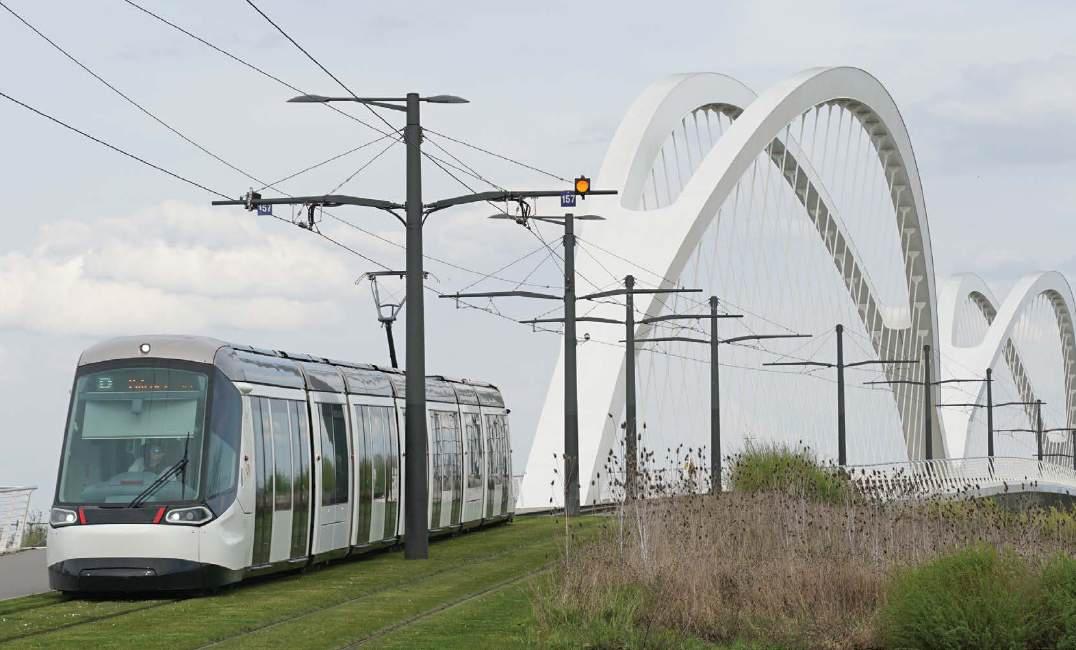
aBove: Strasbourg’s light rail system offers striking architecture, but also inbuilt practicality: here the posts combine with streetlighting.
To overhead or not to overhead – that is the question. And it’s a question that tramway builders and operators have been wrestling with for over 140 years.
When Werner von Siemens demonstrated that a rail-mounted vehicle fitted with a dynamo could be powered from a remote electricity generating station, he fed the power to it through the running rails. That had hazard written all over it, and the solution was to put the power cables in a trough or conduit between the running rails. But, as Blackpool’s tramway found, this was also fraught with difficulties, namely salt water ingress and sand.
Running the power supply through wires suspended off the ground ticked a number of boxes. It kept electricity away from people and offered greater reliability, as it proved to be more resilient to weather. Blackpool switched to overhead wires 14 years after opening in 1885.
Another benefit to using overhead wires is that it can take up to 50 000 volts of alternating current (ac). The current European standard (including in the UK) is 25 000 volts. That is far more than thirdrail systems, which vary, but can be up to 1500V dc. Above that, the electricity can arc onto the running rails or, in the case of the London Underground, the metal tunnel rings. That’s why LUL adopted the 630V dc fourth-rail system (third rail +420V and the fourth/centre rail being -210V) – which is still the case on the deep tube network. More recently the voltage on sub-surface lines has
richard Foster provides an overview of one of the fundamentals of most tramways around the world: overhead.
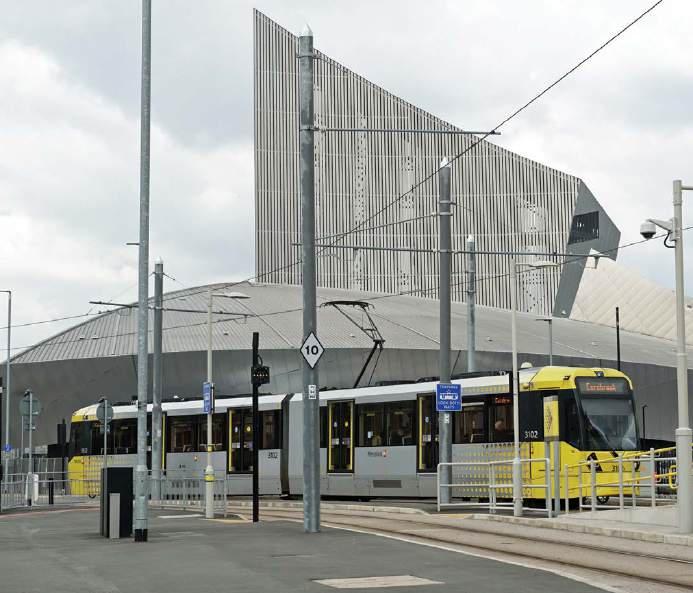

overhead can be used in tunnels, as pictured here at haymarket. Neil Pulling
riGhT: overhead wires can cause conflict when trams need to traverse historically and culturally sensitive areas. The case of Bordeaux caused alstom to develop its aPS (Alimentation par sol) system, where contact strips are raised between the rails to make contact with a shoe under the tram. here, the centre rail is not raised, but importantly is only live when the tram is over the rail – the tram length is therefore longer than the live section.
Neil Pulling
been increased to 750v (third rail at +500V and the fourth centre rail at -250V). Where the Underground shares lines with the National network, the third rail is +750V and the fourth rail acts as the return.
That ability of overhead wires to carry higher voltage is a boon to main line rail networks which require heavy trains to move at higher speeds. But overhead becomes more problematic in the world of light rail, where wires are coming into closer contact with people and buildings. In the UK, the Office of Rail & Road limits overhead wires to 750V dc over public highways.
Overhead can be used in tunnels – Tyne and Wear Metro is proof of that – but third-rail-type systems are better suited to underground lines. Wires are also prone to being affected by the weather and high winds can be particularly problematic.
But its biggest negative is one of aesthetics. Overhead wires require supporting on poles (or masts) and this can come into conflict with historically sensitive areas. For example, the United Nations Educational, Scientific & Cultural Organisation (UNESCO) raised concerns that installing overhead on the proposed Bergen-Åsane tramway extension in Norway would have a detrimental effect on the historic harbour of Bryggen. UNESCO was apparently satisfied when it was suggested that trams through this World Heritage Site would use overhead-free systems (TAUT 1028).
Bryggen is not the only World Heritage Site affected by tramway construction. Bordeaux is another, specifying no overhead in key areas, and it’s the reason Alstom developed its Alimentation par sol (APS) system, whereby contact strips are raised from places of safety between the rails to make contact with a shoe under the tram. Other manufacturers have developed similar systems to get around the issue of having the power feed at ground level. Advances in battery and supercapacitor
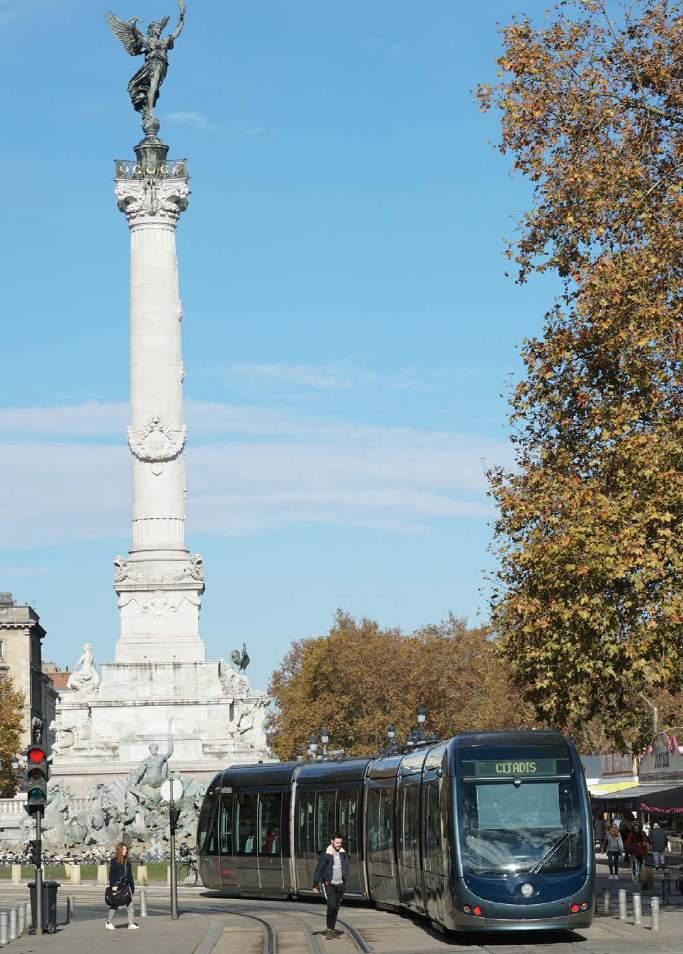
technology are helping a gentle move away from overhead for new tramway construction.
But the use of overhead wires isn’t dead. For example, all seven of Britain’s tram networks use overhead wires. Promotional literature from West Yorkshire Mass Transit says that it will “be powered by electricity, either from overhead lines or from batteries”. The only exception is expected to be Phase 1 of Cardiff’s Crossrail, where battery power is to be used over its 5.6km (3.5 miles).
This is in contrast to the UK’s heavy rail network where new lines are opening without any provision for electrification. Of course, when it comes to light rail, there are very few alternatives to electric power!
It’s also worth pointing out that while light rail overhead follows the same basic principles as heavy rail catenary, there are a few differences. Curves in overhead line could cause the wires to sag more than those on straight track, so tensioning devices are used to mitigate that – for example, the running wire can be tensioned to prevent this. Curves on tramways are also often at tighter radii than those found on railways.
Tram lines cross each other more frequently than heavy rail lines, often at acute angles. Arranging overhead wires over such crossings also needs careful planning.
Given that seeming shift towards alternatives, it’s pleasing to report that there’s still much innovation going on in the world of overhead wires.
Italy’s Bonomi Group has unveiled what it calls Leonardo, the “complete tramway system”. This comprises cross-span wires, knife-switches (switches with exposed metal contacts) and tensioners, which go by the wonderful brand name of ‘T-rex’.
What catches the eye, however, is Leonardo’s posts. They look stylish and feature built-in street-lighting as well as the ability to be enhanced with seating and waste bins.
There is more than 15 000km (9000 miles) of tramway around the globe and the greater proportion of this will use overhead wires. So, as you will see over the following pages, there is a huge market for overhead-related products, with myriad manufacturers and suppliers developing and producing new overhead equipment.
Where does one start with a new overhead system? Let’s begin with the organisations that can offer turn-key overhead solutions. SPL Powerlines is a good place to start, providing “electrification, power and distribution solutions for local mass transit and main line infrastructure”.
Based in Coatbridge, to the east of Glasgow, this company – which has hubs around the UK – can take you through the whole overhead installation process, from planning to testing and commissioning.
Balfour Beatty is another organisation that can deliver
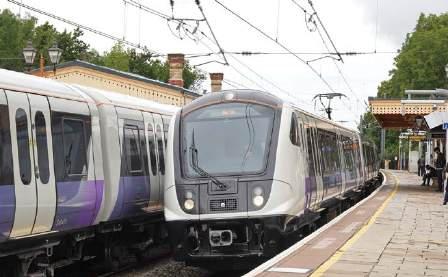
What is involved in installing overhead wires? Edinburgh Trams offered a concise account that divided the installation into two broad ‘types’. One was the use of a central pole between the running lines that are fixed to bases, anchored in the ground. The other ‘type’ is where span wires are attached to buildings. In this instance, it says that “a work platform is set up… a power drill will be employed to drill a hole and install the fixing. Following a suitable ‘curing’ period for the resin anchor, the contractor will return to inspect and test the installation. At a later date, the OLE cables will be attached to the fixing.”
The passage of a pantograph over the wires will generate noise and so RIBE of Germany has developed a wall fastening that includes sound dampening. It has also developed what it calls a ‘wall rosette’, a decorative surround that helps reduce the visual impact of wallmounted overhead.
PACE Networks offers a breakdown of the components required to install overhead wires: the post, tensioning devices to keep overhead wires taut, insulators, droppers, clamps, earthing devices and isolation and switching devices.
There are various tools and pieces of equipment designed to make overhead installation easier. Pandrol offers the P1800 Laser Height & Stagger Gauge. This enables the relationship between rails and wires to be accurately measured from ground level. P1800, says Pandrol, is “robust and lightweight” and can even cope with super-elevated track.
ELAG Elektronik AG is a Swiss organisation that specialises in monitoring equipment. OPTIMESS can not only monitor existing
overhead design, installation and testing. It announced in late 2024 that it was investing GBP5m (EUR5.9m) in its Power Transmission & Distribution business. It has invested in eight new puller/ tensioner machines and 20 new winch tractors. These machines will be used across its business, from high tension wires on pylons to rail electrification.
Keltbray “offers a complete overhead line service from design to test and commissioning”. It has a list of heavy rail credits but has also worked on several metro systems, including Crossrail (the Elizabeth Line). It is currently installing masts on the South Wales Metro.
PACE Networks “[act] as the connection between leading global manufacturers… and rail
electrification markets in the UK and Ireland.” It works closely with Bonomi Group, supplying bespoke products including Leonardo to the UK. It has also developed PEAR Pac – effectively a back-pack designed to hold portable earths and other equipment, leaving hands free and removing potential trip hazards. Pod-trak was formed in 2007 and has worked on many UK rail projects. Two are directly relevant to the world of light rail: it undertook overhead line installation on London Overground’s 4.5km (2.8-mile) Barking Riverside extension in 2019-2022 (as well as undertaking all track and associated civil engineering work). It was also responsible for installing overhead line on Manchester Metrolink’s Phase 3 extensions.
LeFT: Keltbray offers a complete overhead line service from design to test and commissioning, and has also worked on several metro systems, including the elizabeth Line (pictured). it is installing masts on the South Wales Metro. Neil Pulling

aBove and BeLoW: edinburgh Trams’ system features two ‘types’ of installation: the first uses a central pole (pictured here in edinburgh Park business district), the second uses wires that span between buildings (pictured in Shandwick Place). Neil Pulling
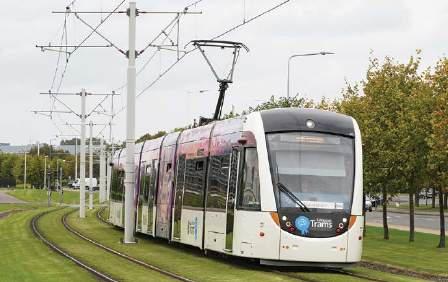
overhead but also new installations, checking “their current elevation and lateral position”. The OPTIMESS CSD version is a free-standing scanning device while OPTIMESS 2D sensors are attached to an item of rolling stock. This, says ELAG Elektronik, “facilitates highly accurate measurement of the overhead wire in relation to the middle of the track”.
Of course, installation of overhead line cannot be carried out at ground level. Mobile elevating work platforms are required, and VolkerRail recommends the RR14 EVO-2/400 as being “ideal” for overhead line installation (as well as inspection and maintenance). It’s a self-propelled ro-rail machine that boasts an articulating and telescopic boom lift with a platform capable of holding three people.

Let’s now delve a little deeper into key components of overhead line. Most light rail systems use cantilever posts where wires are not being suspended from buildings. Here, a single post has ‘arms’ – either one or two depending on the application – which hold the wires. This is in contrast to portals which have two uprights – often either side of the lines – and a linking crosspiece.
WEC Rail designs and manufactures overhead line portals and cantilevers from its factory in Darwen, Lancashire. This means that it can “manufacture poles to any height or loading specifications and can customise poles to… exact requirements.”
Progress Rail, as you might expect from a global rail conglomerate, offers a vast range of post-related products. These range from column and base steel work to foundation piles and cast iron parts and balance weights. Some overhead posts can look somewhat functional but Dutch firm PMF Steel Poles offers a range of stylish items that can also incorporated street lighting. Worthy of mention are its E005 poles with “architectural mastarms”. These support double line overhead from one pole and are ideally suited to tramways with
roads either side. The streetlights are suspended over the carriageways in dramatic fashion. Another eyecatching offering is the E012 gantries, which look like giant, swooping croquet hoops. These are best employed on reserved or segregated sections of tramway.
One final PMF Steel Poles product to look at is E009. This is a ‘T’ shaped gantry – again, it’s easy on the eye –specifically for supporting wires on sharp tramway curves.
Leonardo is not Bonomi Group’s only innovative product. It has various dedicated light rail and metro overhead solutions and has supplied them from home projects, such as the Translohr guided tramway in Padova (Padua) or REM in Quebec, Canada. But it has joined forces with two other Italian companies (GCF and Satferr) to develop OMNIA. This is described as a “smart cantilever for railway overhead line”. It’s made from aluminium in order to be lightweight and corrosion resistant. Bonomi also claims that it is easy to install and requires minimal maintenance. It is, the company says, being used on 27km (16.7 miles) of double track light rail in the Middle East although it doesn’t specify where.


aBove: The wiring itself can prove quite complicated, as demonstrated here in Bern, Switzerland, at a point where tram lines cross.
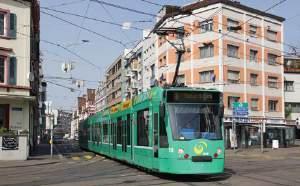
aBove: Junctions and crossings can also create a puzzle of wiring, so need special consideration –pictured here is a crossroads on Spalenring in Basel, Switzerland. Neil Pulling
Another key component of the overhead is the wire itself and, again, there are numerous organisations innovating in this arena. Belgian firm Lamifil has developed PowerFil, a new alloy developed for overhead line applications. What the alloy comprises has not been disclosed but Lamifil says that it “offers significantly superior properties compared to conventional CuMg [copper-magnesium]”. This includes “less resistance and heat losses, allowing more trains to run on the same track” while requiring less copper in its manufacturing.
Another item in the Pandrol catalogue is its Rigid Catenary System. This “offers an alternative to conventional catenary where an extruded aluminium profile is clamped to the contact wire”. It particularly suits tunnels and subways due to its small dimensions, and there’s also no tension on the wires and no risk of the wire breaking when worn.
Another firm offering a range of wire solutions is Germany’s Rail Power Systems. These come under the TracFeed brand. While TracFeed ALU3000 can be used for high speed railways with speeds of up to 330km/h (205mph), ALU1000 is most suitable for most subjects covered in TAUT. This, RPS says, is “optimised for trams, urban and suburban railways with rated voltages of between 600V and 1500V”, allowing for speeds up to 120km/h (75mph).
But there’s more to the overhead than just the contact wire. RIBE offers a full range of OHLE fixtures and fittings, from insulated line hangers to tension wire clamps, but it also claims that its factory in Roth, about 30 mins south of Nuremberg, is carbon neutral. It has achieved this by supporting a wind power initiative in Thailand that offsets approximately 117 849 tons of CO2 per year.
Swiss firm Kummler & Matter has an equally impressive range of wire-based products. Worthy of mention is KUDISC. This is designed to permit the silent crossing of a pantograph over the overhead wires at a junction. It’s designed to be lightweight, requires minimal maintenance and can be offered at angles from 50 degrees to 90 degrees.
Overhead is the same as any other part of the tramway or metro system in that it requires regular maintenance. There are plenty of suppliers and manufacturers offering products and services designed to keep overhead wires in tip-top condition.
Swiss manufacturer MATISA, which celebrates its 80th anniversary in 2025, produces the M10 track inspection vehicle. While its primary role is inspecting the state of the permanent way, it can also inspect the position of the track against the overhead wires.

Deutzer, from Zeuthen near Berlin, produces a range of measuring devices, covering all aspects of light rail operation. But its overhead measuring devices can assess wear on the wire, the impact between pantograph and contact wire as well as voltage and current draw.
Another firm based near Berlin is PANTOhealth. This offers a vehicle-mounted camera and a point cloud scanner that monitor both pantograph and overhead wire simultaneously. Danish company PantoInspect also produces a scanning system, which can be used on rail systems up to 330km/h.
One of the benefits of overhead compared with a third-rail system is that it is more resilient against icing during winter months. But it is affected by freezing temperatures and so Kummler & Matter has developed its KUPRO De-icing system. This can be positioned in passenger trams and deposits a de-icing spray onto the wire via the pantograph.
Tram overhead shares some similarities with heavy rail overhead. Heavy rail – and metro systems such as the Tyne and Wear Metro – use a system whereby the contact wire is suspended from a catenary wire by droppers. The cantilever – which reaches out from the post –holds both the catenary and contact wires. Tram systems just have a contact wire. This helps to minimise the equipment suspended in the air and thus reduces static and ice/wind loads on the poles and their foundations.

Amongst many transport improvements introduced to support hosting the 2004 Olympic Games, Athens opened the country’s only public tramway.


Modern Greece dates from 1832, with Athens designated as the capital in 1834. The picturesquely ruinous state of those buildings surviving from Ancient Greece is partly due to sheer age, but also reflects conflicts which led to national independence. Periods of monarchy, enemy occupation and domestic military rule followed.
From 1974, a return to democracy –a system ascribed to originating in Athens – led to Greece joining the European Economic Community in 1981. In the European Union’s
Eurozone by 2001, Greece headed towards financial crisis and ‘bailout’ austerity measures. Although unsuccessfully bidding to stage the 1996 ‘Centennial’ Olympic Games (Athens hosted the first modernera games in 1896), in 1997 the city was designated as the venue for 2004. Despite later concerns over preparedness, both bids prompted transport improvements. These were much needed beyond the scope of the Games however, for Athens had become notorious for chaotic traffic and air pollution.
The capital of the Attica region, Athens municipality has about
ABOVE: Alstom Citadis X05 20056 draws away from Dimarcheio on Piraeus Municipal Theatre Square on 25 February. The tramway extended here in December 2021, with the adjoining metro line 3 terminus (named Dimotiko Theatro) added in October 2022.
660 000 residents. The metropolitan area with 58 municipalities served by the public transport network has a population of around 3.7 million. Once an extensive system, electrified in 1908, Athens’ metregauge tramway was closed in 1960 in favour of buses and trolleybuses, modes which remain significant in the network. Some street track from the early tram system remains near an entrance to Akropoli metro station. With construction started in early 2002, Athens opened a 1435mmgauge tram system in July 2004, offering transport for several Olympic venues when the Games took place
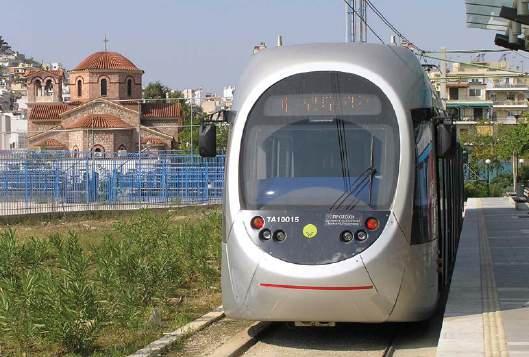
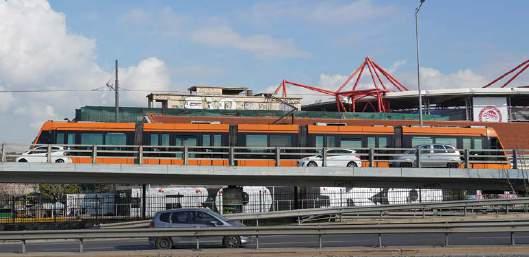
The two Athens tram types are bi-directional, air-conditioned and fully low-floor. Fleet numbers are preceded by TA; various advertising formats appear on both types. The AnsaldoBreda Sirio (10001-10035) cars retain a mainly silver livery. The 32-metre long, 2.4-metre wide five-section Sirio was styled by the Italian automotive design specialists Pininfarina. It is signed for a capacity of 54 seated, 197 standing and four designated wheelchair spaces. Although the system did not extend much proportionally with the addition of Piraeus, an order was placed with Alstom in 2018 for 25 Citadis X05 (20036-20060). With similar external dimensions as the Sirio, the Citadis are visually very different due to a bright orange and black livery and have easier internal circulation. Assembled at Alstom’s Santa Perpetua de Mogoda (Barcelona) factory, they were delivered in 2020-21 and entered service in December 2021. Each Athens Citadis X05 has capacity for 54 seated and 214 standing. Even with some Sirio vehicles now inactive, the less numerous Citadis seem to handle a greater proportion of services.
TOP LEFT: Stadio Irinis & Filias (SEF – Peace and Friendship Stadium, a 2004 Olympic venue) when it was the initial system’s western terminus, seen on 6 October 2005.
LEFT: With tracks diverging for the Piraeus loop, Karaiskakis Stadium and SEF tram platforms are widely separated. A Piraeus-bound Citadis climbs the ramp next to Faliro metro stop near the home of Olympiakos football club.
BELOW: Restructured for the Piraeus extension, this is Stadio Irinis & Filias (SEF) stop in February 2025. Terminus platforms can be used for services in connection with events at the two nearby stadiums or if the Piraeus loop is unavailable.
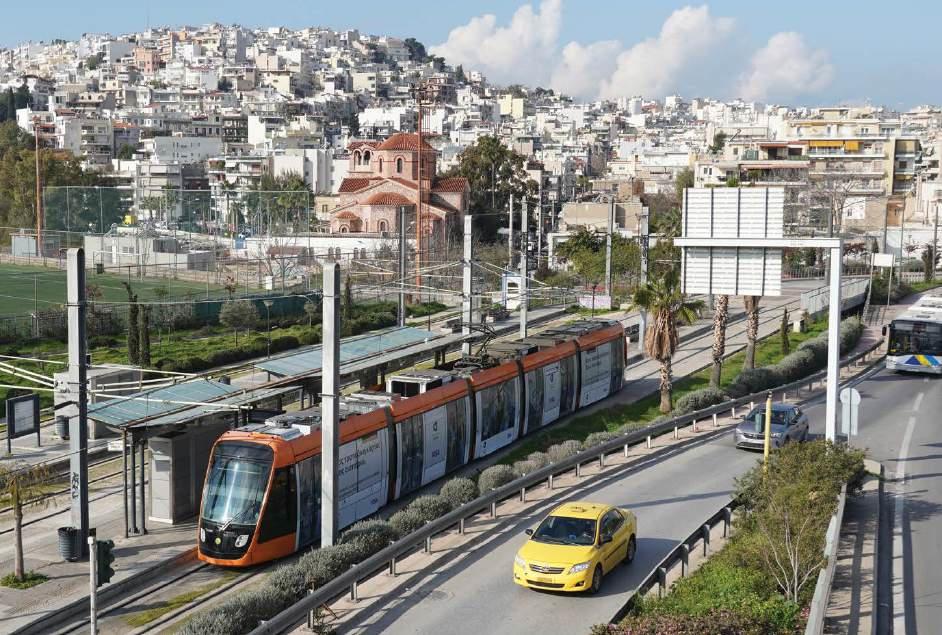

during the next month. From the outset the tramway became part of the Syntagma central interchange, joining a convergence of metro and bus routes. Rather than replicating its predecessor’s intricate urban coverage however, the tramway was primarily a connector of inner and coastal suburbs. Reflecting practice amongst new tramways then opening across Europe, the project incorporated landscaping to improve the new service’s surroundings and easy access to low-floor trams. Signage has Greek lettering with Romanised counterparts, with audio including English content.
The initial system was bi-directional with overhead supply throughout, had 49 stops and used Italian AnsaldoBreda Sirio trams. It was double-tracked with some brief divergences, running mostly in reserved space beside or in the centre of main roads. Mainly bordering the Saronic Gulf coast, tracks from the western terminus at Stadio Irinis & Filias (SEF) ran to the prosperous south-eastern Glyfada municipality and resort area. From Kolymvitirio stop in Glyfada, an 800-metre extension in November 2007 went to Asklipeio Voulas, which remains the terminus with four platform faces on stub tracks. About 400 metres short of Asklipeio Voulas is a pair of incomplete and unused platforms. The tramway’s major extension, from SEF into Piraeus, lay 17 years ahead of the system’s debut. The other initial system route, the city arm rose from the coastal route at a delta junction between Batis and Edem stops to end at Syntagma Square. This is the site of the Hellenic Parliament Building and on the edge of the main
shopping district. Syntagma remains a terminus, but in 2019 was rebuilt with a twin-track island platform to replace the original single-track layout. Historic features border the approach to Syntagma Square, which has the National Garden and Roman ruins nearby. Panathenaic Stadium, the main venue for the 1896 Olympic Games, is near Zappio stop. Here the platforms are widely separated due to a vertical divergence of tracks on a hillside. The Temple of Olympian Zeus and Zappeion Hall are either side of Leoforos Vasilissis Olgas, a picturesque wide avenue taken by the tramway.
Replacing earlier arrangements including running three lines over a then-shorter system, two lines are now used, with previous line numbers abandoned. Mainly using the city arm and scheduled to take 35 minutes, T6 runs for 18.2km (11.4 miles) between Syntagma and Pikrodafni, a stop between a seafront marina and the busy coast road. Trams working T6 turn back from platforms on both sides of Pikrodafni’s central track, with outer platform faces used by T7 trams. The two lines thus only have direct interchanges here and at Edem, although Batis (T7) and Mousson (T6) are only a short walk apart. The 16.1km (10.1-mile) line T7 connects Asklipeio Voulas with Piraeus, the location of the biggest change to the as-opened system. Depending upon the direction of travel around Piraeus, a trip between termini is scheduled for 51 or 57 minutes. T6 has the slightly more intense service with a core 9-12 minute frequency; T7 is scheduled for 12 minute intervals. Bunching of services and longer intervals can arise, possibly relating to multiple traffic intersections and
Tramway opened: 2004
lines: 2 tram; 3 metro
Approx. weekday hours: 05.30-00.30
line frequency: 9-12 minutes
Gauge: 1435mm
Power: Tram 750V dc, overhead supply
Power: Metro 750V dc third rail + (line 3) 25kV ac overhead supply
Tram fleet: 60
City transport authority: Transport for Athens OASA www.oasa.gr
Tram and Metro operator: STASY www.stasy.gr
Civic information: www.cityofathens.gr and https://piraeus.gov.gr
Tourist information: www.thisisathens. org and www.piraeus.org
“Historic features border the approach to syntagma square, which has the National Garden and Roman ruins nearby.”

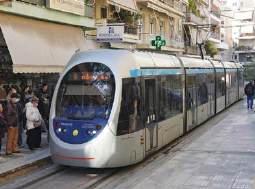

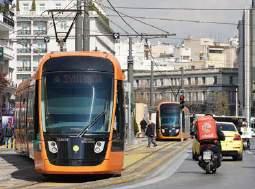
LEFT: On a track divergence for the narrow street, a crowd awaits 10030 at the southbound Neos Kosmos platform: released by a traffic blockage, two more trams followed in quick succession.
LEFT: Shelters at the unused Akti Poseidonos terminus seem to have become shelters of another kind.
LEFT: The approach to the terminus at Syntagma Square is beside a busy road taking traffic into the city centre.
a proportionally small part of the system sharing road space.
A naval base in ancient times and centuries before becoming a single metropolitan area, the main identity of Piraeus remains its role as the port of Athens. Also handling freight and cruise liners, Piraeus harbour is the main hub of ferry links with Greece’s many islands. The Piraeus tram loop consisting of about 5km (3.1 miles) of single-track route had a delayed opening in December 2021, which also saw the introduction of a second tram type, the Alstom Citadis X05
To enable the extension, a new track divergence was installed between Neo Faliro and SEF stops, with trams to Piraeus taking the more inland track. This rises close to the home of Olympiakos football club, Karaiskakis Stadium, which is the name of the tram stop here, although the nearby metro station takes the Neo Faliro name. At this point, platforms of the stadium tram stops are about 100 metres apart, connected by a footbridge over the road.
Towards central Piraeus with Lambraki stop above and Androutsou below, the inbound track passes over the outbound, creating a mostly single-track clockwise circuit. Although trams mainly have reserved space, there are many conflicts with other traffic. Despite being close to and named after Holy Trinity

Aghia Skepi
1. Karaiskasis Stadium
2. Mikras Asias
3. Lambraki
4. Evangelistria
5. Platia Deligianni
6. Dimarhio
7. Akti Posidonos
8. Aghia Triada
9. Platia Ippodamias
10. 34th Syntagmatos Pezikou
11. Androutsou
12. Omiridou Skylitsi
13. Irinis & Filias Stadium (S.E.F.)


Syntagma
Zappio
Fix Leoforos Vouliagmenis
Kassomouli
Neos Kosmos
Baknana
Aegeou
Aghias Fotinis – Plateia
Megalou Alexandrou
Aghia Paraskevi
Medeas-Mykalis
Evangeliki Scholi
Amfitheas Achilleos
Panaghitsa
Mousson
Marina Alimou
Kalamaki
Zefyros
Loutra Alimou
Helliniko
1st Aghiou Kosma
2nd Aghiou Kosma
Aghios Alexandros
Hellinon Olympionikon
Kentro Istioploias
Platia Vergoti
Paralia Glyfadas
Paleo Dimarhio
Helliniko
Platia Vasso Katraki
Asklepieio Voulas
Holy Trinity Cathedral
Agia Triada, the nominal T7 Piraeus terminus. Track in the foreground leads to the future Akti
Cathedral, the T7 terminus, Agia Triada, has a low-profile setting compared to preceding Dimarcheio on Municipal Theatre Square. Intended to be temporary, the terminus role is nominal as trams are not held at Agia Triada. With access from a delta junction between there and Dimarcheio, the completed but unopened Akti Poseidonos stub-track terminus for T7 is about 200 metres from the active revenue tracks. Adjoining a ferry quay, Akti Poseidonos has fallen into disrepair, with the shelters seemingly used by street dwellers. Tracks outbound from Piraeus connect with the original system at SEF, which was changed to include through-platforms. The
“Passenger services on the national railway network around the metropolitan area have changed greatly in the 21st century.”

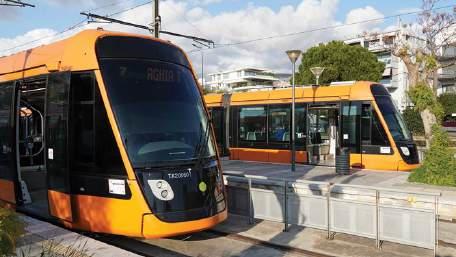
BOTTOM:
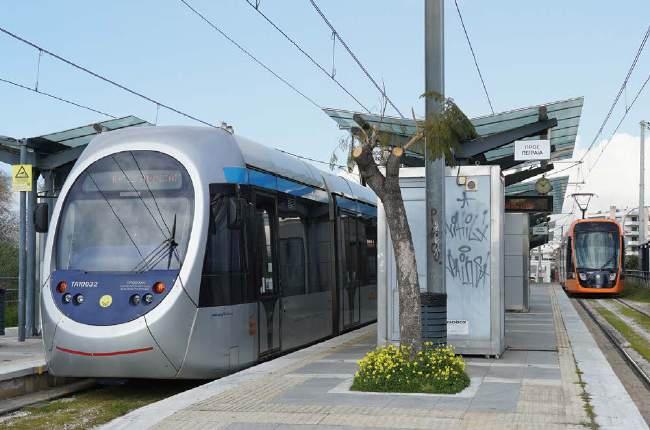
stub track platforms remain available for stadium events or maintaining services if the Piraeus loop becomes unavailable.
The tramway has a single depot which is some distance from revenue tracks, located near the north-east of the Athens Ellinikon airport site, which closed in March 2001. There is an approximate 2.4km (1.5-mile) access from a delta junction just south of 2nd Aghiou Kosma stop. Part of this extensive site had some Olympic venues, since abandoned, but otherwise remains under development for varied uses. In the longer term this should add patronage to the tramway which borders the western perimeter, approximately between the present stops at Platia Vergoti and Loutra Alimou.
Passenger services on the railway network around the metropolitan area have changed greatly in the 21st Century, notably on routes designated as the Athens Suburban Railway. Investment is evident in recent electrification, new track and the extensive modern main station. This is designated as Athens but is also known by a predecessor name, Larissa, as is the adjacent metro station. Despite these changes, the intensity and capacity of passenger services remain lower than might be expected for a sizeable European capital.
The high-volume urban rail mode is the Athens Metro. It consists of three lines, designated as 1 (green on official diagrams; length 25.7km/ 16.1 miles), 2 (red – dark blue on our


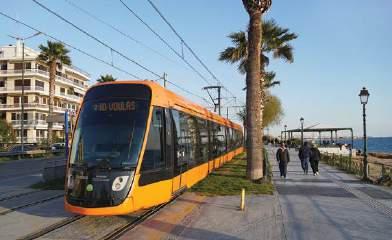
version here; 18.7km/11.7 miles) and 3 (blue; 47.3km/29.6 miles).
Designated as metro in 2000, line 1 is markedly different from the other two, being adapted from a local railway which was opened in 1869. Electrified in 1904, it runs from a western terminus dating from 1928 close to the inner end of Piraeus harbour (the separate modern Suburban Railway terminus is 100 metres away). By 1957 the service had extended 25.7 km (16.1 miles) to the present line 1 terminus at Kifissia. Unlike the later lines, much of line 1 is at or near ground level. Overlooked by the Acropolis, it crosses the northern edge of the Agora, Athens’ ancient political and commercial area. A downside of the surface presence is that graffiti, widespread across Athens, is very marked on line 1. The first parts of metro lines 2 and 3 opened in January 2000, with both since extended. The three lines converge in the centre, forming an interchange triangle between Monastiraki (which includes an archaeological site), Omonia and Syntagma, the latter being the busiest
LEFT: Athens has around 360 trolleybuses: the Van Hool A300TSfakianakis 7000 series dates from 1999-2001.
RIGHT: Undergoing reconstruction, Leoforos Vasilissis Olgas which is lined by historic sites is on the approach to Syntagma terminus.
LEFT: Leaving the coastal strip with a T6 service to Athens, Sirio 10012 leaves Mousson towards the Church of the Dormition of the Virgin Mary.
RIGHT: The vandalised Breda vehicle 82 near the Kassomouli platforms is a relic of the Piraeus – Perama interurban line.
LEFT: Most of line T7 follows the Saronic Gulf coastline. The setting sun emphasises the orange livery of 20060 near Flisvos.
RIGHT: Dualsystem Rotem stock works metro line 3 between Piraeus Dimotiko Theatro and Athens Airport station (pictured).
Athens station. Construction began in late 2021 for a 13km (8.1-mile) first stage of a fourth metro line, being Greece’s biggest active public works project. Originally developed as separate entities, in June 2011 the metro and the trams came under common management and operation by the public sector urban rail body STASY. This is a subsidiary of the Athens Urban Transport Organisation (OASA). The OASA bus and trolleybus counterpart to STASY is OSY. Athens Eleftherios Venizelos International Airport, which opened in 2001, is about 20km (12.5 miles) east of the city centre. Rail services from the station, which is run by the airport authority, were launched just before the 2004 Olympics. The present coverage is by two services, mainly taking different routes to link the airport with Piraeus. At the eastern end metro trains share tracks with the Suburban Railway east of the separate Doukissis Plakentias stations. Most metro line 3 trains terminate here, with the designated twice-hourly airport services being operated by Rotem dual-system stock.
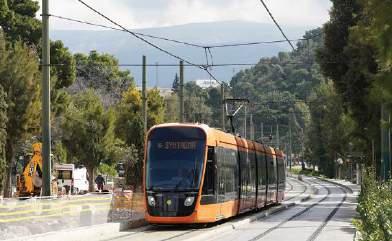


local travel: The anonymous rechargeable cross-mode card styled ATH. ENA TICKET is of most use to visitors: 90-minute tickets at EUR1.20; 24-hour EUR4.10. Clearly aimed to encourage public transport use by the short-stay market – highly relevant to Athens tourism – the 3-Day (3 x 24 hours) Tourist Ticket at EUR20 includes a return fare for the airport. Ticket machines at the airport, metro stations, some tram stops plus staffed kiosks. Ticket validation required; travelling revenue protection teams. Full ticket details at www.oasa.gr (information as April 2025).
What is there to see? An overall view of the urban spread extending to Piraeus from Lycabettus Hill (paths and funicular, nearest metro line 3 Evangelismos).
This viewpoint is high enough to overlook the Acropolis, listed by UNESCO as “...the most striking and complete ancient Greek monumental complex still existing...” The south-eastern entrance near metro line 2 Akropoli station is one of several including displays of ancient artefacts. Hourly changing of the guard ceremony at the Parliament building, Syntagma Square. East of Thiseio station, Adrianou (street) which follows Metro line 1 has views of the Agora and Acropolis, also many restaurants. Tightly packed around the north-eastern edge of the Acropolis, the Plaka district is also a prime tourist area. Activity at Piraeus port can be observed from some open-access quays, although care is needed due to vehicle movements.

Andrew Grahl visits Phoenix in the US, where a South Central metro extension is due to open at the start of June –linking up to the Valley Metro.
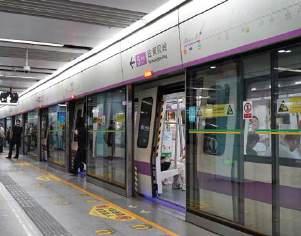
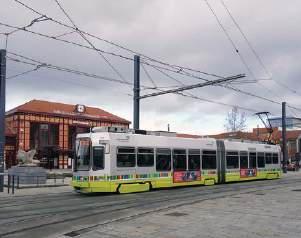
Hans-Ulrich Riedel explores the cities of the Pearl River Delta in the second part of his China feature, uncovering the rapid expansion of metro in the country.
One of the few French cities never to have lost its first generation tramway, the network is modern and up to date, as Andrew Thompson discovers in France.
+ Liège, Belgium: A city update
+ Classics: The Paulo Marques Museum, Lisbon + The latest news and analysis, system and technical development






MELBOURNE. All under 18s will be able to apply for a Myki card from 1 January 2026. This offers free weekday travel on buses, trams and trains throughout Melbourne and parts of the state of Victoria. IRJ
WIEN (Vienna). Line 18 is diverted via Ungargasse until September due to the reconstruction of Schlachthausgasse.
The use of high-floor E2+c5 trams on two Line D school day workings is to cease from the start of the summer school holidays.
Alstom Flexity 409 was delivered on 15 May; 410 followed on 23 May. EB
WIEN–BADEN. Operational eight-axle high-floor trams in May were 108/112/115-116/120/ 123-126.
The Leesdorf depot, built in 1873, was closed on 5 April. A new depot has been built nearby. tramwayforum.at
ANTWERPEN (Antwerp). Line 15 trams are using a temporary section of single track in Lakborslei to 29 August. The same applies on line 9 along Herentalsebaan from 1 June for about 18 months. Line 24 is cut back to Muggenberg and is operated by double-ended trams.
T-2000
BRUXELLES (Brussels). Line 97 is to be suspended from 9 June due to highway reconstruction work. From this date, articulated PCCs will only run on lines 39 and 44. It is expected that 7900-series trams will take over before the end of 2025. T-2000
GENT(Ghent). Line 4 is cut back to Sint Pieters Station until mid-July because of work to construct a new terminus at UZ (University Hospital). T-2000 LIÈGE. Services started on 28 April as reported in TAUT 1050, but the official inauguration took place on 10 May when HM Philippe, King of the Belgians, drove CAF tram 5110 from the depot to the city centre. There was public entertainment at each of the 23 stops along the line. Facebook
OTTAWA. There was a weekend of free public transport on 3-4 May as OC Transpo thanked residents for their patience during a year of poor service. skyscrapercity TORONTO. Tram lines 503, 504 and 508 have been diverted for several weeks from 11 May while
water mains are replaced on King and Church Streets. There’s no service on King Street between River Street and Spadina Avenue. From 16 May, the diversion route for line 504 was changed from Spadina Avenue to Shaw Street.
P. Webb
NINGBO. Metro line 4 was extended by 2.5km (1.6 miles) from Dongqian Lake to International Conference Center on 16 May. urbanrail.net
OSIJEK. The first of ten new Koncar trams (2501-10) carried passengers for the first time on 30 April. cs-dopravak
OLOMOUC. New EVO1 bogie trams 125+126 entered service in April. They are coupled back-toback. transphoto.org
PLZE Ň Car 404 became the latest Škoda 40T ForCity Smart to be delivered. It arrived at Slovany depot on 23 May. J. Siehofer PRAHA (Prague). On-street testing of the new Škoda 52T tram (TAUT 1050) started on 26 April; it needs to satisfactorily accumulate 20 000km (12 427 miles) before it can enter passenger service.
The tender to refurbish T3 trams 6312, 6892, 6921, 7122, 7188 and T4 5500 has been won by the Brno tramway undertaking at a cost of CZK59.9m (EUR2.4m).
Three consortia have been shortlisted for the Czech Republic’s first railway Public-Private Partnership project: to build a new line from Ruzyně to Vaclav Havel Airport by 2030. The winner of the 25-year contract is to be announced next year. The new line is to reduce the journey time to the city centre to 25 minutes.
M. Baxter, cs-dopravak, IRJ
KØBENHAVN (Copenhagen). Test running on the Glostfrup –Ishøj section of the new light rail line is underway. ‘Bytrafik’
HELSINKI. The European Investment Bank is to provide EUR250m in funding for the Crown Bridges light rail line. It’s due to be completed in 2027. IRJ
FRANCE
AUBAGNE. Tram services are suspended until at least 1 July while Gare Aubagne terminus is rebuilt.
The La Bouilladise extension should open in May 2026. lineoz.net

BESANÇON. The first of five new 34m Alstom Citadis trams has arrived (TAUT 1050). An option has been exercised for three to be delivered in 2026-27. lineoz.net DIJON. Public consultation on a third tramway is to take place between 2 June and 1 August. The 10km (6.2-mile) line would run south-east to north-east via the city centre. Costing EUR300m, it could open in 2030. Y. Allain LYON. Construction of 24.6km (15.3 miles) of new tramway has led to line T1 now running from La Doua Einstein to Halle Tony Garnier until the end of August, in preparation for the connection with future line T9. Line T3 is not operating between Part-Dieu and De La Soie to permit a crossover to be installed for the extension of line T6. Y. Allain MONTPELLIER. The first powered test on the northern section of the future tram line 5 to Clapiers took place overnight on 20-21 May. Services are set to start on 20 December. midilibre.fr NICE. Tram services were suspended until midday on 25 May after an attack on a substation serving the city. BBC PARIS. Line T1’s first generation TFS low-floor trams are to be withdrawn by September; tram 216 will be preserved.
The first Alstom metro train for future line 18 was delivered to Palaiseau workshops on 14 May. Ile-de-France Mobilités has ordered a further 96 RER NG double-deck EMUs from Alstom to complete the re-equipment of line D at a cost of EUR2.1bn. Line D has received 36 NG sets since December 2024. IRJ
BAD SCHANDAU. The Elbe bridge reopened for light traffic
(TAUT 1047) but remains closed for buses. A ferry link from Bahnhof to a new landing stage was introduced at the end of March.
All museum trams are to be in action throughout the 25th Kirnitzschtal Fest on 26-27 July, along with depot visits. BS BERLIN. Driver training on Urbanliner trams 5001-3 started on 9 April. They are due to enter line M4 service this summer.
Trams were no longer able to run between Karlshorst and Oberschöneweide from 19 May due to the closure of a road viaduct for safety reasons. This is to be demolished in June. Lines M17, 21, 27 and 37 are affected. Services from the north turn at Blockdammweg, while lines 21/37 are combined as a through service. To the south, line 67 is extended to Adlershof Ballast replacement on the viaduct between Gleisdreieck and Nollendorfplatz should be finished on 5 June, allowing the small-profile U-Bahn network to return to normal. Shuttle trains were operated on the remaining sections.
Work on the Krumme Lanke Mexikoplatz line U3 extension started on 28 April. BS BRANDENBURG. Driver training with the new Škoda trams (TAUT 1047) started on 5 May. BSŠ BREMERHAVEN. IVV of Aachen has won the contract for the feasibility study into a new tramway (TAUT 1050). DS CHEMNITZ. Verkehrsverbund Mittelsachsen has signed an agreement with DB to run tram-trains over the closed line to Limbach-Oberfrohna. This service could start in the 2030s. Tatra set 519+509 is to offer public trips from the former
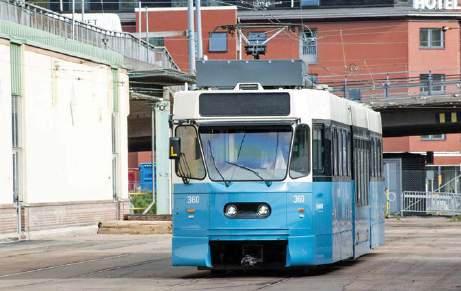
Kappel tram depot, which is now the Garagen Campus, a “cultural hotspot” for the 2025 City of Culture. Museum trams are housed in the campus’ eastern hall. DS COTTBUS. Škoda had delivered trams 1-4 by 6 May.
Through services on line 3 to Madlow have resumed. BS DRESDEN. A special council meeting to discuss the financial situation ( TAUT 1049) decided to increase the headway on tram Line 7 to 20 minutes. There have been reductions in bus services, while funicular fares have increased.
Trams are to gain advertising liveries. Car 2721 now carries a scheme promoting Chemnitz as 2025 City of Culture. BS DUISBURG. Alstom continues to deliver new GT8ND trams; 2030 has arrived.
Lines 901 and 903 are home to the last 18 ten-axle trams. BS DÜSSELDORF. Alstom was to have delivered the final two HF6 trams, 4358/9 shortly after this issue closed for press.
The last Stadtbahn-B cars in service are 4002/03/06. They are mainly used on line U78. Opening of the airport extension (U81) has been postponed until spring 2026.
Structural problems in Am Steinberg depot’s central hall have led to the suspension of museum tram operations. BS FRANKFURT-AM-MAIN.
Tenders are to be issued for 30 tram-train vehicles for Regionaltangente West.
T class trams were still out of service at the end of May; they are being sent to Alstom in Hennigsdorf for rectification.
Tram 749 has lost its advertising livery in favour of standard turquoise colours.
Line U2 will be cut back from Gonzenheim to Ober-Eschbach temporarily from December to
permit the start of work on the extension to Bad Homburg. BS, DS GENERAL. Germany’s coalition government voted to retain the Deutschlandticket on 30 April. This offers unlimited local public transport for (currently) EUR58 per month. Patrick Schneider became Federal Minister for Transport on 6 May. UTM GERA. The city council has approved the purchase of between three and six new trams.
Two-axle LOWA trailer 234, built in Gotha in 1956 for the DR Klingenthal – Georgenthal line, moved to Kraków in April. It is be restored as Poland’s only EB54 BS HAMBURG. U-Bahn line U5 is now due to be completed in 2040, five years later than the last estimate. BS HANNOVER. The Fasanenkrug turning circle was closed on 26 April. The 69-year-old facility made way for a Bike+Ride area and a stub terminus.
Glocksee depot is to be rebuilt at a cost of EUR200m.
Museum trams 178, 601 and 6001 were used on May Day specials. DS HEIDELBERG. Tram 3271 became the last MGT6D to be sent to Schöneiche, where it will become number 67. BS KARLSRUHE. Services have resumed to Menzingen and Odenheim after the fatal level crossing accident ( TAUT 1049).
Operator AVG has opened a fund for the victims’ families. BS KÖLN (Cologne). KVB Personnel, Police and Ordnungsamt staff have been clearing drug users and overnight sleepers from subway stations, particularly Neumarkt and Ebertplatz.
Green Party councillors have called for a referendum on the subway alignment of the proposed east-west axis (TAUT 1050).
Lines 13 and 18 are due to resume operation across the
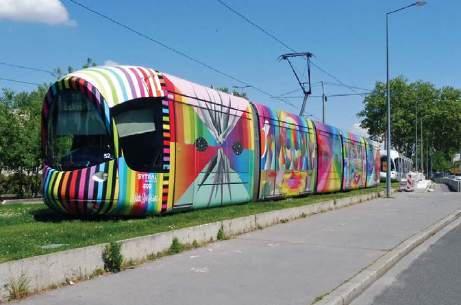
rebuilt Mülheimer Brücke from 15 September. DS LEIPZIG. Alstom and HeiterBlick have agreed for 49 Sachsentram tram bodies to be built at Alstom’s Görlitz factory. The first 25 are also to be painted there, by the end of March 2026. BS MAINZ. Trams resumed passing through Münsterplatz from 3 May. The city council has agreed that the route of the new city tramway bypass should be Ludwigsstrasse – Flachsmarkt – Grosse Bleiche – Rheinallee with new tracks in Goethestrasse. Work is unlikely to be completed until 2035. BS MANNHEIM. Work to repair the Rheinbrücke started on 14 April but trams will not return across it until early 2026. BS MÜNCHEN (Munich). Line 19 resumed operation to Pasing from 28 April.
Temporary tram Line 37 was closed from 9 May when line 17 resumed operation across the Ludwigsbrücke after more than four years of reconstruction work.
SWM is preparing a tender for 56m trams to operate the Tram Westtangente that will extend line 12 to Olympiapark West. On the night of 5-6 May test runs took place here with three-section Avenio trams 2757 and 2758.
Museum trams are hoped to be in operation before the 150th anniversary of tram operation takes place in October. DS NÜRNBERG (Nuremburg).
Stadler Variobahn trams 12011208 were withdrawn in April. These non-standard vehicles date from 2007-09, and some are stored in the disused tram tunnel in the southern suburbs.
Line 8 is to be curtailed at Hbf from 10 June to 13 December to permit work on the extension to Stadtpark. BS ROSTOCK. Stadler TINA tram 802 was delivered on 17 April. Goetheplatz has re-opened after three years of work. BS
RUHRBAHN. After the last Stadtbahn-M trams ran in Essen on 17 March, 1156/62/71/72 remain at Stadtmitte depot.
Alstom delivered NF4 1076 in May.
Tenders have been issued for up to 49 40m trams. BS SAARBRÜCKEN. Services were suspended between RiegelsbergSüd and Siedlerheim after a lorry crashed on to Saarbahn tracks. Repairs to track, overhead and platforms at Heinrichhaus took several days. sr.de WÜRZBURG. HeiterBlick delivered tram 216 on 25 April. The 18 new trams are not due to enter service until October. DS ZWICKAU. Line 4 had to be closed between Neumarkt and HeinrichBraun-Klinikum from 5 May. As a result, line 3 now runs Eckersbach – Neumarkt – Neuplanitz. Line 34 is now Neuplanitz – Neumarkt – Pölbitz and Line 43 is Pölbitz –Neumarkt – Eckersbach. BS
AHMEDABAD. The 2.4km (1.5-mile) Gandhinagar Sector 1 – Sachivalaya extension of metro line 2 opened on 27 April. urbanrail.net
BENGALURU. The Pink Line metro is now expected to open in late 2026 due to delays with the supply of rolling stock. However, the Central Silk Board – KR Pura section of the Blue Line is expected to open this year, with KR Pura – Kempegowda International Airport following in early 2027. The 19.1km (12-mile) Yellow Line is complete but, again, opening has been delayed by the late delivery of its 15 trains. IRJ MUMBAI. Metro Line 3’s 9.8km (six-mile) Bandra-Curla Complex to Acharya Atre Chowk extension opened on 10 May. urbanrail.net
MANX ELECTRIC RAILWAY. Car 16 has received new whitemetal
armature bearings. They were cast in the Derby Castle smithy. Car 32 undertook ‘drying out’ runs on 20 May, when it ran at low speeds to enable heat from the motors to remove damp due to winter storage. It returned to service on 21 May.
RAILWAY. The island’s Department of Infrastructure is recruiting for an Electrical/ Mechanical Rolling Stock Fitter to work on the SMR’s passengercarrying cars and infrastructure equipment. The closing date was 9 June.
ROMA (Rome). Track replacement at the end of Via dei Castani has affected services. Line 19 is replaced by buses 519, 19L and 19NAV (ATACs suggests that line 19L is still a tram but that’s not confirmed) while line 5 is not running. Line 14 is replaced by bus 514. M. Willsher
TORINO (Turin). New metro Line 2 is to be equipped with 60m automated trains (either four or five cars). Construction of the 16.6km (ten-mile) Rebaudengo – Porta Nuova – Politecnico –Anselmetti line is due to start in 2026. lineoz.net
ASTANA. The first two LRVs from CRRC Tangshan China have arrived at the depot. transphoto.org TEMIRTAU. Four of the new Chinese-built trams are in regular service on the rebuilt tramway, operating every 22 minutes. No fares are charged. BS
RIGA. Line 2 became line 8 from 1 May and now runs over line 5’s tracks to M ī lgr ā vis. New line 14 runs between I ļģ uciems and Ķengarags every 30 minutes. BS
MEXICO CITY. Metro line 1’s Cuauhtémoc – Chapultepec section reopened on 23 April following refurbishment carried out by MexiRRC, the local subsidiary of CRRC.
Line 18, an elevated Bus Rapid Transit trolleybus, opened on 18 May. The 18.5km (11.5-mile) line, which includes a 7.2km (4.5-mile) viaduct, links Chalco with metro line 8 at Santa Marta. It cost MXN7.52bn (EUR344m) and uses 108 vehicles from Yutong Bus. RGI, TP
DEN HAAG (The Hague). Track relaying means that line 1 is cut back from Delft to ‘s-Gravenmade until 18 July. OR
ROTTERDAM. The new bridge over the river Maas at De Esch will be served by trams rather than buses but won’t open until 2035.
Heritage tram line 10 runs Thursdays-Sundays between 19 June and 14 September. It then reverts to Saturdays/Sundays only until 26 October. OR
BERGEN. Stadler has won a EUR50m contract to supply signalling for the planned 12.7km (7.9-mile) Åsane tram line. RGI
PANAMA CITY. Daegu Transportation and Hyundai Engineering have been awarded a contract to maintain the 26 trains and 28 sets of points on monorail line 3. RGI
ELBL Ą G. The city has awarded Turkish manufacturer Bozankaya its first Polish order. It is for ten three-section trams, worth PLN77.2m (EUR18m). PESA supplied the only other bid. cs-dopravak
LISBOA (Lisbon). Remodolado two-axle tram 557 has been equipped with LED destination displays. The route now carries an ‘E’ suffix (for electrico), such as 28E. M. J. Russell
RUSSIA
KALININGRAD. Electricallyoperated points are being installed over the summer to improve the service.
Tatra KT4 theatre tram 415 is to operate on Friday/Saturday/ Sunday evenings throughout June. J. Carpenter
MOSKVA (Moscow). Moskva 2020 train 75326 was repainted in its original brown and yellow livery to mark 90 years of metro operation on 17 May. A parade of trains complemented a rolling stock exhibition at Sokolnicheskaya Ploschad. transphoto.org
SANKT PETERBURG (Saint Petersburg). Udelnaya metro station reopened after refurbishment on 25 April. transphoto.org
SARATOV. The 71-923M lowfloor three-section trams 23512358 entered service on line 8 from 1 May. transphoto.ru
YEKATERINBURG. PKTS has delivered 71-911EM Lyonok bogie tram 840. transphoto.org
SAUDI ARABIA
RIYADH. Tenders have been issued for the construction and operation of a seventh metro

line. Bids for the 65km (40-mile) Qiddiya Entertainment City - King Khakid International Airport line were due on 15 June. RGI
SLOVAKIA
BRATISLAVA. The 3.9km (2.4-mile) extension of the cross-river tramline from Jungmannova to Janíkov Dvor was to open in June. BS
VALENCIA. It was hoped to resume operation on the metro line south to Torrente and Castelló in June after completion of flood repairs. BS
BASEL. Austrasse is closed for complete reconstruction until the end of 2026. Line 6 is diverted via Markthalle. Services were boosted over 12-18 May thanks to the Eurovision Song Contest. Special Ring Line T operated around the central area every 20 minutes. Delegations to the opening ceremony on 11 May were brought in by heritage trams. Düwag tram 628 operated as a Karaoke Tram from 11-17 May. BS MARTIGNY–ST-GERVAIS (TMR/SNCF). Stadler delivered the first of seven new Mont-BlancExpress Beh4/8 units (Z891) on 24 April. They should enter passenger service in mid-2026. railwaypro ZÜRICH. Tram tracks at HB station are to be re-laid during 12-31 July. This will require widespread diversions but what they will be is not yet clear. BS
GÖTEBORG
Škoda Group delivered 360, the first refurbished M31B , on 24 April. The 1991 ASEA tram is to be followed by 78 more.
The new line to Lindholmen will open on 14 December. Line 12 will run Mölndal – Skånegatan – Lindholmen. Facebook
BANGKOK. The THB4bn (EUR108m) Pink Line monorail extension to Muang Thong Thani has been offering a free trial service since 20 May. Revenueearning services on the 2.8km (1.7-mile) line are to start on 17 June. urbanrail.net
BLACKPOOL. Blackpool Council and Blackpool Transport have agreed to implement measures so that heritage trams can run from 15 October. The ‘Western Train’, the ‘Frigate’ and a Balloon are set to run until January 2026.
CARDIFF. Preparation work to electrify the 1.6km (one-mile) branch to Cardiff Bay took place between 10-25 May. A second platform was also constructed. Electrification will permit the use of Class 398 tram-trains.
EDINBURGH. Edinburgh Trams’ ‘tap-on-tap-off’ payment system – dubbed ‘ToTo’ – went live on 19 May (TAUT 1050). The system works across the tram network and Lothian Buses.
Sheriff Douglas Keir has determined that the death of bus driver Carlos Hernan Correa Palacio, when he was hit by a tram in 2018, could have been avoided. However, the Fatal Accident Inquiry (FAI) report published on 13 May said that Sheriff Keir was satisfied that Edinburgh Trams has implemented the recommendations made in RAIB’s 2019 report.
GLASGOW. The Unite union has confirmed that Glasgow Subway workers could strike if negotiations fail to give them the same terms as drivers and station staff.
INDUSTRY. Dan Hill is UKTram’s new Knowledge Manager. He will oversee the creation of a dedicated reference library and Request for Information (RFI) archive, which UKTram says is a long-requested resource for members.

LONDON (DOCKLANDS).
Cutty Sark station closed on 31 May to allow new escalators to be installed. Transport for London promises that they will have more efficient motors as well as other energy-saving features. The station is to re-open in spring 2026.
LONDON (UNDERGROUND).
A power cut in the afternoon of 12 May forced the suspension of services on the Bakerloo Line while bringing disruption to the Jubilee, District, Circle, Piccadilly, Northern and Waterloo & City lines as well as the Elizabeth line and parts of the Overground. The power cut was on the National Grid.
Work on the ‘Bollo Lane’ redevelopment at Acton is due to start this July. Frank Pick House, home to London Underground’s Escalator Engineering department, is to be demolished and new houses built on a strip of land between the District/ Piccadilly Lines south from Acton Town station and Bollo Lane itself. Future development plans could include building houses on land currently occupied by the London Transport Museum’s store.
NORTH WALES. Plans for a metro-like service in North Wales have been unveiled. Network North Wales proposes improving services from Liverpool to both Llandudno and Wrexham, running Holyhead – Manchester Airport services, electrification and ‘tap-in-tap-out’ payments. It is not yet clear where funds for the GBP2.1bn (EUR2.5bn) plan would come from.
SHEFFIELD. Supertram marked its ten-millionth passenger journey under public ownership in early May. SYMCA celebrated a year of Supertram public ownership on 22 March.
Bendy buses returned to Sheffield for the first time in over 25 years as they were used for tram replacement services on 24-30 May, during infrastructure renewals in the Hillsborough area. Further work will require bus replacements from 28 July to 15 August – although this could be extended to 30 September. Work between Hillsborough Interchange and Middlewood also requires replacement buses from 16-29 August, possibly September.
STOURBRIDGE. Geoff Lusher has stepped down as Chair of Pre Metro Operations, operator of the Stourbridge shuttle, after 12 years. His successor is Steven Jasper.
TYNE & WEAR. All five Stadler Class 555s in service were taken out of traffic in late April/early May after a fault allowed all doors to open when at stations, rather than on the platform side only. The fault has now been rectified.
Fare-dodging on the Metro is now down to almost pre-COVID levels. Operator Nexus recorded that fare dodging took place on 4.6% of journeys in 2024, which is close to the 4% recorded in 2019. This had jumped to 8% in 2021.
Replacing key overhead equipment in the tunnel between Monument and Haymarket required services to be suspended from 21.00 on 18 May. The scale of the work could not be fitted into a standard night shift. There was to be further disruption 29 May –1 June when bridge repairs, level crossing upgrades and signal cable renewals closed the line between Airport and Regent Centre for four days.
DRUZHKIVKA. A Russian drone strike on 9 April hit the depot and destroyed ex-Praha (Prague) trams 7010/88 and damaged many more. Services resumed the next day using two Tatra trams. BS
KHARKIV. Tramway operation on line 5 beyond the railway station to Odessaer Shosse resumed on 25 April. BS
ATLANTA, GA. Alstom delivered the first of 29 Innovia APM300R people-mover cars to Plane Train at Hartsfield-Jackson airport in early May. RGI DENVER, CO. RTD has lifted speed restrictions on lines D, H and R after completion of maintenance work. It then carried out maintenance work on Line A between 26 April and 8 May. J. May NEW YORK, NY. Governor Hochul signed legislation to fully fund MTA’s USD 68.4bn (EUR60.4bn) 2025-29 Capital Plan on 9 May. This will be partly financed by a payroll tax increase but MTA will still have to find USD3bn (EUR2.7bn) in efficiencies or other savings.
NJ Transit commuter rail services were cancelled on 17-19 May for the first time in 40 years, due to strike action. J. May
PHILADELPHIA, PA (SEPTA).
The Chestnut Hill East commuter rail service will be suspended from midnight on 15 June until 2 September to permit bridge reconstruction work. Additional services will be provided from Chestnut Hill West and bus line 23. J. May
SAN FRANCISCO, CA. A technology failure shut down BART operations for several hours on 9 May. Control staff were unable to monitor the location of trains. SF Chronicle
Muni is to add four additional schedules to heritage Line F this summer, bringing the total to 16. This is partly to help out with a reduction in bus services along Market Street.
Muni Heritage Weekend is scheduled for 20-21 September, with two ex-Blackpool Boat trams expected to run as well as the 1896 two-axle tram. J. May
SANTA ANA. Orange County Streetcar’s Siemens S700 tram 101 was unveiled to the media on 7 May. The line will not open to the public until spring 2026. J. May
on a museum bus is still required from Haarlemmermeer Station to Jollenpad. OR HEATON PARK (UK). Heaton Park Tramway is to open its museum on one Sunday a month from 25 May. Work to renew a substation that started in September 2024 continues.
MEISSEN (DE). The former tram depot has been repurposed as a museum for tram-related relics. An open day was to be held on 21 June. dampfbahn-route.de NÜRNBERG (DE). Special tram Lines 15, 17 and 19 operated over the first weekend of May to celebrate 40 years of museum tram operation from St Peter depot. UTM POZNA Ń (PL). Ex-Amsterdam eight-axle tram 805 is due to join the museum fleet this year after restoration. TP
SPIEKEROOG (DE). The metregauge horse tramway is being extended by 1km (0.6 miles). TR STEYNING (UK). Brighton Tram 53 Society raised GBP400 (EUR475) on its 10-11 May open days.
SUMMERLEE (UK). Summerlee Museum of Scottish Industrial Life has been awarded a GBP148 000 (EUR175 950) grant from the National Lottery Heritage Fund to develop a bid for the GBP3.4m (EUR4m) it needs to carry out large-scale projects on the site. Artists’ impressions show a recreated street with a tramway down the middle.
WINDSOR, CA. 1918 bogie tram 351 has been restored for display at a new Waterfront plaza called Legacy Beacon Park. Trams ran in the city from 1872 until 1939. msn WROCŁAW. Kraków two-axle Linke-Hofmann tram 1076, built in 1926, was used to provide passenger trips on tourist line T on 10-11 May.
Worldwide items for inclusion should be sent to Michael Taplin at Flat 8, Roxan Villa, 33 Landguard Manor Rd, Shanklin, Isle of Wight PO37 7HZ, UK. Please fax: +44 (0)1983 862810 or e-mail miketap@mainspring.co.uk UK and Ireland items, please e-mail uknews@lrta.org
WASHINGTON, DC. Automatic train operation on the metro’s Yellow and Green lines started on 23 May.
MUSEUM NEWS
Mass Transit
ACTON (UK). The London Transport Museum has launched an appeal to raise GBP30 000 (EUR35 500) for new moquette for two of its Q Stock cars.
AMSTERDAM (NL). The museum tramway’s half-hourly Sunday service to Amstelveen resumed from 6 April, but a ride
Acknowledgements are due to Blickpunkt Straßenbahn (BS), BSŠ, ‘Bytrafik’ , cs-dopravak, dampfbahn-route.de , Drehscheibe (DS), Eisenbahn (EB), International Railway Journal (IRJ), lineoz.net, Mass Transit, midilibre.fr, msn, Op de Rails (OR, Railway Gazette International (RGI), SF Chronicle, skyscrapercity, sr.de , Today’s Railways (TR), Tram-2000 (T-2000), tramwayforum.at, transphoto.org, transphoto.ru, Transport Publiczny (TP), urbanrail.net, and Urban Transport Magazine (UTM).
the light rail sector continues to play a vital role in shaping sustainable, efficient urban mobility and uktram has been working hard to support innovation and continuous improvement across the industry.
We’re pleased to share the news of strategic partnerships, working group outputs, new leadership appointments and knowledgesharing initiatives. Here’s what we’ve been up to in 2025 so far.
Strengthening cross-sector collaboration
The partnership was teased at Rail Forum’s flagship Parliamentary Reception in April by Transport Committee member and Derby North MP Catherine Atkinson, as well as during a subsequent event at the RaisE Business Centre in Goole, where the theme of cross-sector collaboration took centre stage.
“Collaboration between industry bodies like Rail Forum and UKTram is essential,” said James Hammett, UKTram Managing Director. “By aligning our efforts, we provide even greater value to the wider transport industry.”
The move builds on our ongoing commitment to pansector partnership. We also became corporate members of the Permanent Way Institution (PWI), with Managing Director James delivering a keynote at the PWI’s technical seminar in Nottingham. Our membership reflects the growing engineering focus within light rail and a shared desire to raise standards across infrastructure and safety.
This summer also marks UKTram’s third year as an ambassador member of Women in Transport, with our involvement aligning firmly with our organisational values and board diversity. We were delighted to attend the 20th anniversary celebration in June, hosted at the iconic London Transport Museum.
Additionally, we’re pleased to announce our status as a Corporate Champion of Campaign for Better Transport, supporting that group’s drive for light rail in the UK.
Our working groups continue to drive industry-wide learning and peer support. The most recent Light Rail Operators Committee (LROC) and Light Rail Engineering Group (LREG) meetings were held in Sheffield.
During LROC, key topics included patronage recovery, driver recruitment and the integration of modern technologies such as Overspeed Protection systems.
LREG featured UK system updates, partner contributions from the RAIB and LRSSB, and technical presentations on energy storage and innovation in track infrastructure. The LREG Best Practice Day focused on electrical isolation training and competence, supporting safe systems of work.
Key appointments
UKTram is delighted to confirm the appointment of Chris Hopkinson, Head of Metro Operations at TfWM, as Chair of the Owners and Authorities Group. He is joined by Stuart Lowrie from the City of Edinburgh Council as Vice Chair. Both bring extensive experience and a clear vision for the role of local authorities in shaping the future of light rail.
Knowledge sharing remains a cornerstone of our strategy. That’s why we have appointed Dan Hill as Knowledge Manager. Having been part of the UKTram team since 2016, Dan now leads the development of our new Reference Library and RFI (Request
for Information) archive, which is set to become a vital resource for professionals across the industry.
Also now officially part of the team is Chelsea Branch, our Digital Marketing Manager. A long-time collaborator on UKTram’s communications, Chelsea is expanding our digital reach and community engagement, helping to ensure sector progress is visible and accessible.
Tackling social issues through transport
Our involvement with the DfT’s Rough Sleeping on Public Transport Forum continues. UKTram is promoting the StreetLink platform and the #BeTheLink campaign, which empowers staff and passengers to connect people sleeping rough with support services.
“Rough sleeping itself is not anti-social behaviour,” explains Operations Manager Steve Duckering. “Platforms like StreetLink offer something meaningful people can do, moving away from the mindset of ‘nothing we can do’.”
StreetLink will also feature at this year’s Light Rail Summit in Birmingham, where speaker Saffron Gurden will share insights on how the sector can help.
The UKTram Centre of Excellence (CoE) is advancing efforts to develop competent persons for safety validation and influencing international standards. Through ongoing collaboration with the LRSSB, the CoE continues to represent UK interests in standard-setting.
There’s also a strong focus on skills and succession. A pilot scheme in the West Midlands, developed with the LRTA, is looking at new ways to engage apprentices and students in the light rail profession. The CoE has also launched a working group to examine the true cost of tramway construction. The group aims to strip projects back to essential delivery components by challenging the addition of high-cost ‘urban realm’ features, offering a clearer, value-led approach to project planning.
After the reservation of places for key industry leaders were taken, remaining spaces for the 2025 UKTram and LRSSB Light Rail Summit saw an unprecedented response, reaching full capacity just three days after registration opened.
The event, taking place at IET: Austin Court in Birmingham this September, promises to be our biggest yet. The agenda will explore the future of light rail through the lenses of sustainability, integration data and social value.
We’ll be joined by a wide range of partners, speakers and exhibitors, and will share further programme updates in the coming weeks.
Strategic collaborations have certainly marked the first part of the year, expanding knowledge sharing and integration and renewing our emphasis on inclusion and future-proofing our systems.
UKTram is proud to support the sector in shaping a smarter, safer, more connected future for light rail.
Andrew Thompson visits one of Germany’s largest historic tram collections at an atmospheric industrial site in Hannover.
Located southeast of Hannover at Sehnde-Wehmingen, the Hannoversche StrassenbahnMuseum (HSM) features one of the largest collections of historic tramways and related public transport artefacts in Germany.
Just like the Crich Tramway Village in Derbyshire, the UK, the HSM is situated on former industrial premises, with old brick buildings creating an atmospheric backdrop for the historic vehicles. The expansive complex was first used as a potash mine between 1901-28. After minerals extraction had ceased, the facility was converted to a munitions factory in 1937. During World War Two, prisoners were used as forced labour at the site and housed at a nearby camp. After the war, the British Army used the base as a depot and supply camp, before it was handed over to the German Bundeswehr in 1973.
The current society that runs the museum with volunteers was established in 1987. Due to the preservation efforts of a predecessor organisation, at one point a large collection of more than 350 old trams, buses and trolleybuses was stored on site, most of them without shelter from the elements. Because the size and scale of this vast fleet proved difficult to maintain and even harder to manage, concerted efforts
were made to cascade old vehicles to other museums, preservation societies, public transport operators or private collectors. Numerous vehicles, deemed in derelict condition beyond the point of salvage, were also scrapped, although useful spare parts were saved. By 2016, the collection had been reduced to roughly 140 cars, with nearly 70 suitable for display and kept under cover.
Today 17 motor cars and nine trailers are authorised for operation and passenger rides. The museum also maintains a small fleet of active lineside maintenance vehicles for its own purposes, and can conduct minor repairs or larger overhauls in its workshop on site.
The newest addition to the international fleet and also HSM’s first low-floor car is Amsterdam 904 from 1990. It is both the youngest vehicle in the fleet as well as the newest item in the collection. Built in 1990 as part of the partially low-floor 11G series, the tram arrived at HSM in October 2021 and is fully operational, making excursion rides accessible to wheelchair users.
Next to the running sheds and display halls, the museum complex includes a circular running track that makes use of some of the former standard-gauge industrial sidings. The running circuit was built, electrified and enhanced in stages from 2004


to 2015. With the addition of turning loops at both ends, it is also suitable for use by the museum’s countless single-ended cars.
The museum also benefits from an ‘interurban’ line through the countryside. This makes use of the former industrial spur that originally connected the mine with Algermissen station on the Lehrte –Nordstemmen main line. In August 2013 an initial 1.1km (0.7-mile) section of this overland route was electrified, with short extensions being added in 2015 and 2016. Over the full length of available trackbed from the junction with the loop line inside the museum grounds to the bridge over the Hildesheim canal, the overland route measures just over 2km (1.2 miles). However, public excursion rides with double-ended rolling stock typically terminate short of the canal bridge. Following significant wire theft, operations on the overland line had to be suspended in 2021. The entire catenary had to be replaced in May 2024, when service resumed, and new security measures were installed to prevent future incidents.
The HSM is open on Sundays from early April to late October, with additional event dates for Halloween and Santa specials in December. Several times a year, speciallythemed gatherings are also hosted on the museum grounds.
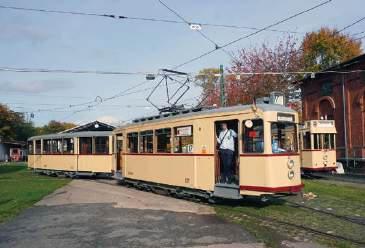
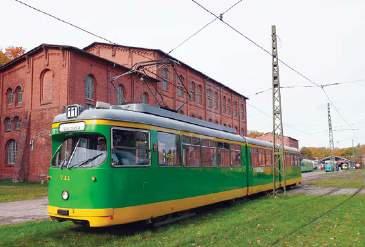
1. The former Hannover set of power car 227 with trailer 1072 are seen on the loop line within the museum grounds. These are wartime austerity designs dating from 1943 and 1947 respectively, but were used in revenue service well into the 1970s.
2. Former Berlin car 5964 dates from 1924 and was built by Hannoversche Waggonfabrik AG (Hawa).
3. A portrait of the Hannover 1940s austerity set.
4. Built in 1969, this classic articulated Duewag GT8 ran in Düsseldorf until 2011, when it was cascaded to Poznań, Poland. It ran there for eight years before being sold to the museum after withdrawal. It arrived at HSM during the pandemic in 2020 and has been used for public trips since 2021.
5

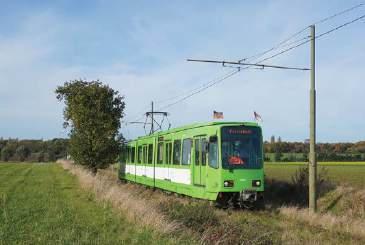

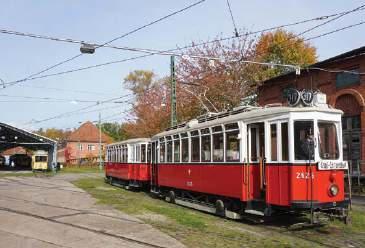
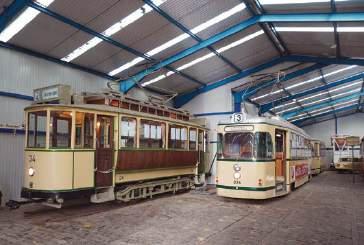
5. Local stalwart 181 is a former Hannover car and was built by Hawa in 1928. Here it is seen running on the idyllic overland route, which is single-track and can only be used by doubleended cars.
6. Drawing power from the newly-fitted overhead catenary which was installed in spring 2024, former Hannover high-floor car 6166 is seen running along the overland route. It was built in 1981 by LHB and sports operator Üstra's frog green livery.
7. A peek inside the tidy exhibition sheds reveals Freiburg im Breisgau 34 from 1909 and former Bonn car 334 from 1953.
8. The running fleet is kept under cover with this half open shed, while the stored, preserved fleet is housed in adjacent buildings that can be fully closed.
9. As the distinctive livery and insignia indicate, motor car 2625 (built in 1921) with trailer 1606 (dating from 1910 and rebuilt in 1957) originally hail from Vienna, Austria.
10. Trailer 2667 is of 1965 vintage and previously ran in Munich. It has been part of the HSM collection since 2000.



By Paul Rowen
The UK light rail industry has just had its biggest boost for many years with over GBP15bn (EUR17.8bn) worth of expenditure for transport infrastructure schemes promised in this parliament. UK Chancellor Rachel Reeves MP made the announcement in the Mellor Coach craft works in Rochdale (my former constituency), followed by similar appearances in Birmingham.
Initial reviews suggest that light rail will get a large share of the allocation, with extension schemes promised for Manchester Metrolink, West Midlands Metro and Tyne and Wear. In addition, Leeds Bradford gets the funding to build its two initial routes, with money also promised for Bath/ Bristol. The latter is one of the schemes the LRTA has been campaigning about for many years, along with many other local groups in the area.
Critics have been quick to pour cold water on the announcement – after all weren’t similar things promised under the Conservatives’ ‘Levelling Up’ agenda? Promises had also been made when Rishi Sunak scrapped HS2 to Manchester.
I don’t share that pessimism... it looks like the Chancellor has rewritten the ‘Green Book’ rules (how the Treasury evaluates the viability of schemes). As an MP when the All Party Light Rail Group held an inquiry into funding light rail schemes, this was one of our biggest criticisms. The use of this
rule resulted in London and the South East getting the lion’s share of any transport infrastructure investment.
Given that local authorities will be implementing the work, we can be sure that there will be a much tighter control of expenditure than that shown, for example, by HS2, where civil servants were responsible for monitoring expenditure.
However, what was not clear from this announcement was if the Coventry VLR scheme was to receive any additional funding. The city has just laid its innovative track and has commenced testing of its vehicle. Several LRTA members have made arrangements to ride on it. If a city like Ghent in Belgium – which is the same size as Coventry – can have a fully-integrated light rail system, why can’t similar towns and cities in the UK? VLR offers the possibility for smaller towns like Stoke and Coventry to get a light rail system, where the heavier metro-type systems would simply be unaffordable. No doubt politicians in Coventry will be pressing Westminster for answers.
So, let’s celebrate and look forward to the annual UK Light Rail Conference in Leeds next month (22-23 July), where we can talk about new schemes and a pipeline of light rail development in the UK.
As the old saying goes, you wait for a bus and then two or three come along all at once!
JULY
Thursday 3. Brentford 14.30. John Parkin: The Michael Cleary legacy. London Museum of Water and Steam, Brentford TW8 0EN. Contact: thamesvalley@tlrs.info £5 inc. refreshments. (TLRS)
Wednesday 9. Sussex 19.40. Richard Salmon: Carriage and Wagon Restoration at the Bluebell Railway. Southwick Community Centre, BN42 4TE. Contact: sussex@tlrs.info. £2 visitors. (SEG)
Tuesday 15. London, 19.00. Ian Ross: Preserving London’s tramway heritage at Crich. The Model Railway Club, London, N1 9DA. £2. (LRTA)
Monday 21. Solent 19.30. Pictures from the TLRS archive. St. Nicholas’s Church Hall, PO17 6HP. Contact Paul Coles: solent@tlrs.info. £2. (TLRS) Saturday 26. Leicester 14.00. Visit to tram infrastructure in Leicester. TBA. Contact: chairman@tlrs.info. (TLRS) Saturday 26. Coatbridge, 13.00. Scottish trams show and tell & talk Contact: scotland@tlrs.info. (TLRS)
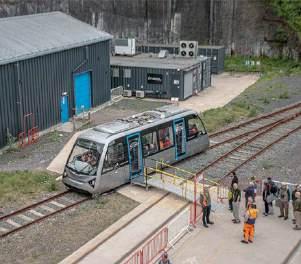
LRTA members will be receiving either as an insert with this magazine or via e-mail, details of the arrangements for this year’s AGM. It is being held in Sheffield at 14.00 on Saturday 4 October.
Nominations are invited for the three retiring Council members and for the post of Secretary – these must be received by the Secretary by 14.00 on 2 August. Members will also be asked to approve the annual accounts and discuss any motions that have been submitted.
Saturday 26. Westhoughton, Bolton 14.00. Arthur Dawson: G scale and 1:16 garden layouts. Contact: archivist@tlrs.info. (TLRS)
Wednesday 13. Sussex 19.40. John Bishop: The Bishop heads east. Southwick Community Centre, BN42 4TE. sussex@tlrs.info. £2. (TLRS) Saturday 16-Sunday 17. Crich 10.0017:00. Model tram, bus and railway exhibition. The National Tramway
www.lrta.org
Museum, Crich Tramway Village, DE4 5DP. Contact: john.huddlestone@ tramway.co.uk. Cost: £25, child: £15 & family: £55. (CTV) Monday 18. Solent 19.30. TBA. St. Nicholas’s Church Hall, PO17 6HP. Contact Paul Coles: solent@tlrs.info £2. (TLRS) Saturday 30. Nottingham 14.00. Bring a thing. Beeston Scout Hut, NG9 1GA. chairman@tlrs.info. (TLRS) Saturday 30. Coatbridge, 13.00. Scottish trams show and tell & talk Contact: scotland@tlrs.info (TLRS)

Order online from www.lrta.info/shop – or by post from:
LRTA Publications, 38 Wolseley Road, SALE, M33 7AU (Please provide telephone contact details and quote LRTA membership number if applicable)
Outside UK = Airmail to Europe (includes all of Russia) / Surface mail to rest of world; Airmail Zone 1 = outside Europe excluding Australia, New Zealand & USA; Airmail Zones 2/3 = Australia, New Zealand & USA

Buses, Trams and Trolleybuses A Photographic Review
A superb collection of images from the late-1940s through to 1970, showcasing the transformation of London Transport’s operations with the demise of both its tram and trolleybus fleets.
> A4 hardback; 192 pages, 350+ black & white pictures.
£44.00 (UK); £57.00 (outside UK); £72.00 (Airmail Z1);
£76.50 (Airmail Z2/3); LRTA Members: £4.00 discount

This fascinating book details all the UK tram schemes that failed to see the light of day.
> A4 softback; 192 pages; 116 colour and 119 black & white pictures; 117 maps.
£23.00 (UK); £30.00 (outside UK);
£37.50 (Airmail Z1);
£42.00 (Airmail Z2/3); LRTA Members: £2.00 discount
Tramways and Light Railways of Barcelona, Mallorca and Valencia in Colour (1954-1980)

The first in a series of three books covering many of the tramways and electric light railways operational in Spain in the mid-1950s.
> A4 hardback, landscape format; 144 pages, fully illustrated in colour throughout.
£42.50 (UK); £54.00 (outside UK); £66.00 (Airmail Z1); £67.50 (Airmail Z2/3); LRTA Members: £3.90 discount

A comprehensive review of the tramways and trolleybuses of Japan with superb track maps for every system. Details of the car types operated and the routes on which they run are covered. English and German text.
> A4 softback; 272 pages, 423 colour and black & white pictures, 48 track maps.
£36.50 (UK); £46.50 (outside UK); £56.50 (Airmail Z1); £61.50 (Airmail Z2/3); LRTA Members: £3.25 discount
For further details of all these books go to our website.
Order direct from the website shown (not from the LRTA)
A social and economic history of the Paris Métro

Comprehensively covers all aspects of the development of the French capital’s distinctive underground rail network and describes its further growth with the new lines under construction today.
> A4 hardback; 272 pages; fully illustrated in black & white and colour. £34.95 – www.platform5.com
Czech & Slovak Railways
Locomotives, Multiple Units, Metros & Trams
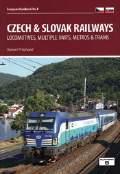
A useful guide to the extensive rail networks in these two central European countries, with good coverage of the tram fleets in Brno, Liberec, Most-Litvinov, Olomouc, Ostrava, Pilsen and Prague, plus Bratislava and Kosice.
> B5 softback; 320 pages; fully illustrated in colour, seven maps.
£31.95 – www.platform5.com
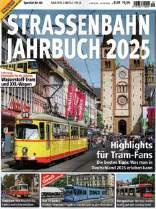
Strassenbahn Jahrbuch 2025 Strassenbahn Magazin Special No. 40
The annual review of tram systems in German-speaking countries with brief reviews from the rest of the world. Features on fifty years ago and tramway museums. German text.
> A4 softback; 116 pages, 300+ colour pictures. EUR 19.90 – www.amazon.co.uk

An unusual book from Ukraine. Detailed history of the system and coverage of difficulties brought about by the Russian invasion. Ukrainian text with QR-code links to relevant material.
> A4 hardback, 156 pages, 400+ black & white and colour pictures, seven maps. Limited quantity available.
£29.00 – www.nationaltrolleybus.org

















